
|
July 12, 2008
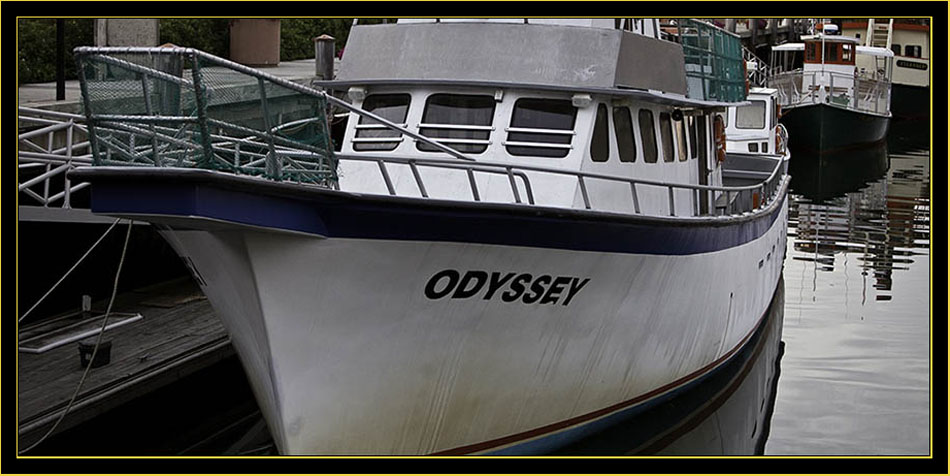
|
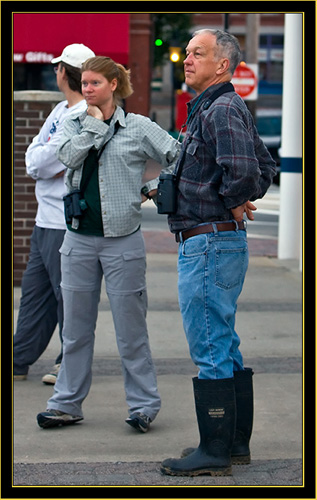
|
I had two unexpected surprises as we milled about waiting. The first was being joined by Dan Nickerson. I’d been informed he was otherwise engaged and wouldn’t be able to make this
trip so was pleased to see he would come aboard and take care of the chumming detail again this year. Like Derek, Dan writes frequently to his interesting blog, Raven Watcher and since our meeting
he and I have stayed in touch via email from time to time.
The second surprise was being joined by another master birder, Jeannette Lovitch. Derek and Jeannete don’t generally take the field together as one is required to remain in the store during business hours. Apprently they worked things out for this event. It was a good to see her and I was pleased she could join us for the morning. There were disappointments as well... This year I came aboard alone as my friends from last year, as well as many other folks I’d talked with about this trip, had plans that precluded their attending. Even my ‘significant other’ Linda had a family obligation and couldn’t make it this time although I had her registered. This wasn’t all negative I suppose because my goal was to concentrate on photography and being on my own simplified this task. After the experience last year I determined to stay near the stern with Dan when the chumming commenced. |
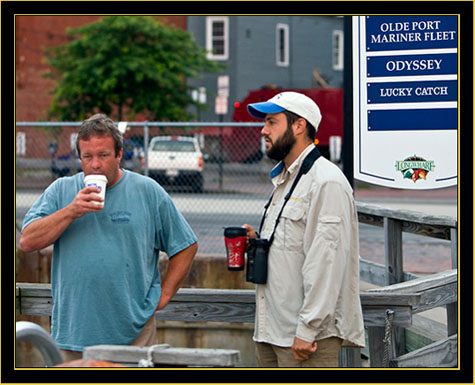
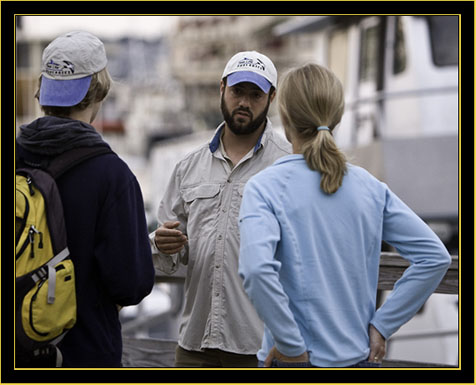
|
|
Captain Dan Yates operates Odyssey from the commencement of warmer weather into the fall conducting whale watching expeditions and charters for various occasions. I really can’t express it better than in my former account...
Trips aboard this vessel are well planned, wonderfully executed and accomplished with alacrity and professionalism. If you have an interest in seeking whales or wish to spend some pleasant time outside the waters
of Portland Harbor you’d be doing yourself a favor in investigating doing so with Odyssey. Please visit their website at Odyssey Whale Watch to learn more about
what they offer.
So as captain & crew prepared Odyssey to start our journey Derek greeted our shipmates for the day and made a few announcements. Our group wasn’t as large as last year but it was a decent turn out and I viewed some familiar faces as we prepared to board. It was a pleasant, fairly warm start to the day. As I looked towards the horizon the sky exhibited almost one-hundred percent cloud cover from my observation point. The sun was getting up a bit & brightening the morning regardless of the thick cloudbanks and it appeared the timing was nearly perfect to enter that ‘golden hour’ photographer’s love so well. As I carried my bag aboard and secured it to one of the cabin benches I was thinking about how best to handle the photographic opportunities on the way out of the harbor. |
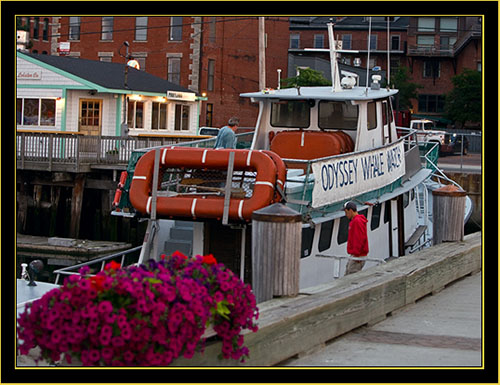
|
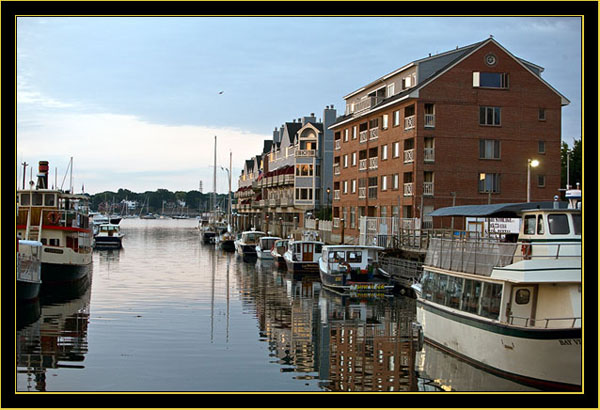
|
The bag I carried contained little besides photographic equipment. I did have two bottles of water, an insulated shirt and my usual skull cap which I prefer to use when imaging. People most likely suspect
I’m an old, leftover hippie or something when I wear one of the many I own in the field. Normally I wear baseball hats but I’ve found these are always in the way when shooting no matter how they’re adjusted and one’s
head should generally be covered in hot or cold weather when in the elements, so my ‘do-rag’ collection serves me well.
I elected to shoot with my primary camera at least to start, the Canon EOS 1Ds Mark III. This is Canon’s flagship pro camera and I’d been using mine since purchased in March 2008. The resolution of this camera is phenomenal and with a full frame 21.1 Megapixel sensor this device will produce an image size of 5,616 X 3,744 pixels, approximately 19 X 12.5 inches shooting in raw format. I won’t get into detail in this account, but I always shoot in raw format to have the most control possible over the image when processing. I had my Canon EF 70~200 f/2.8L Imaged Stabilized lens mounted for the outward leg of the trip to employ the versatility of a zoom along with the low-light capability it offers. In the end result, I came aboard over equipped and other than adding a 1.4X extender to this lens to increase the reach to 280mm, I didn’t change systems due to circumstances and subject selection once we got out of the harbor. I was pleased with the results obtained from this lens set up last year and I recognized it to be a proven performer at sea. The other cameras I carried consisted of my new replacement Canon 5D with a full frame sensor at 12.8 Megapixels & 400mm f/5.8L Super Telephoto lens which I absolutely love for handheld bird shots when panning. However, this lens is not image stabilized which may or may not be an issue depending on light and subsequent shutter speed at sea. And the third was my Canon EOS 40d, a subframe, 10.1 Megapixel camera set up with a short focal length lens, a 28~105mm f/3.5-4.5 zoom. I planned to get some shots on board with this but never did pull it out. |
Off We Go - Some Harbor Views...
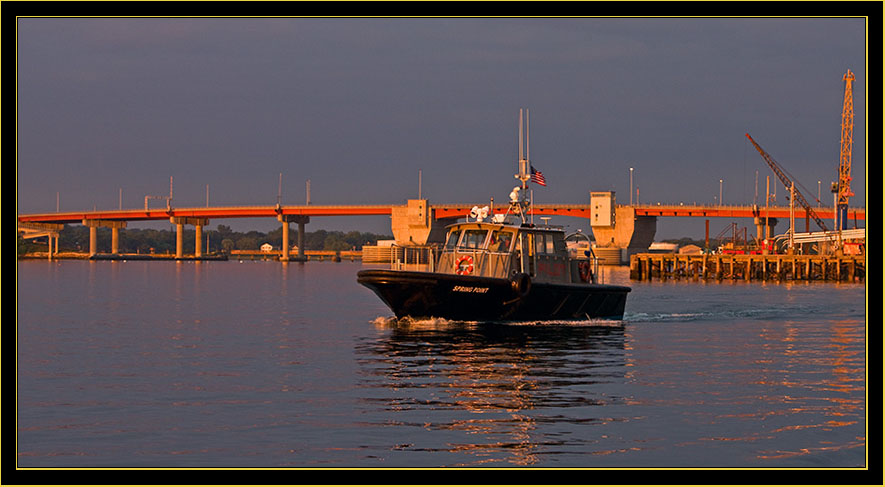
|
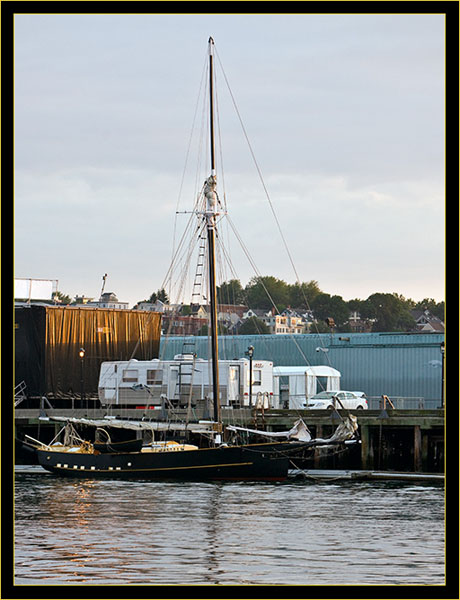
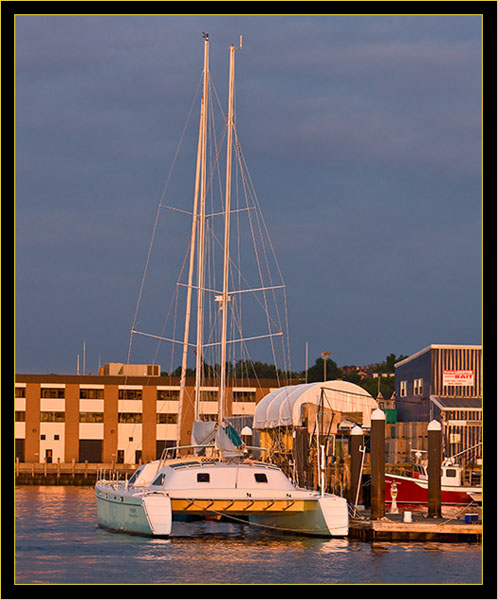
|
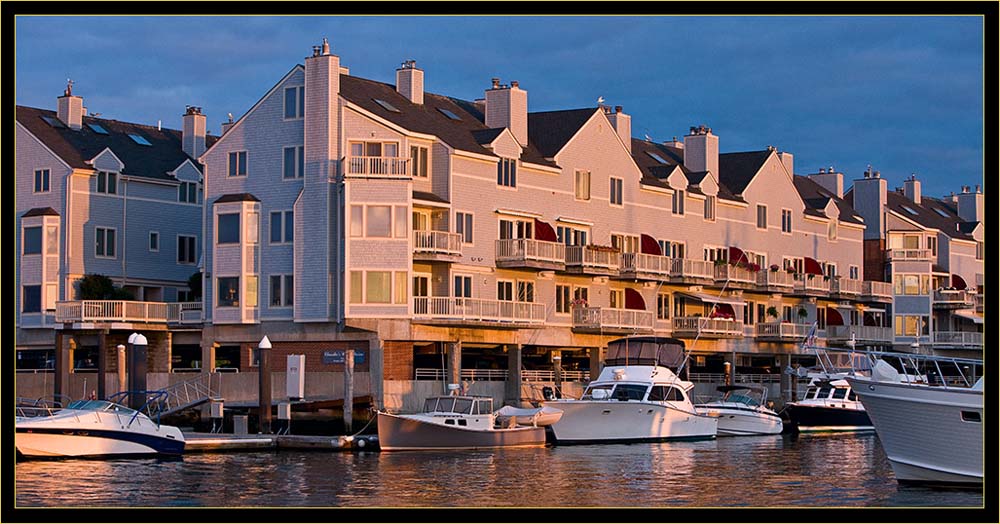
|
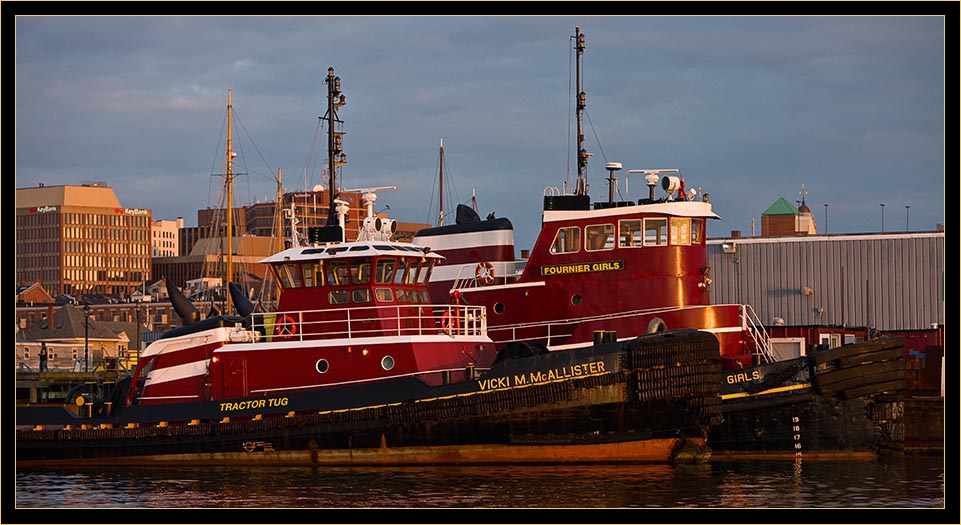
|
The Old and the New - the Portland Observatory stands watch over the high speed catamaran ferry ‘The Cat’.The Observatory, an architectural icon, is a maritime signal tower constructed in 1807 at a time when nothing much could be found atop Munjoy Hill. During the age of sail the Observatory, eighty-six feet in height, allowed a long distance view of ships making for Portland Harbor. There was enough time at that visual distance to arrange berthing or wharf accommodations and to line up stevedores to unload before the ships docked. It was listed on the National Register of Historic Places in 1972. In 2006 it became a National Historic Landmark. Having been recently renovated it is a sterling example from our maritime past. |
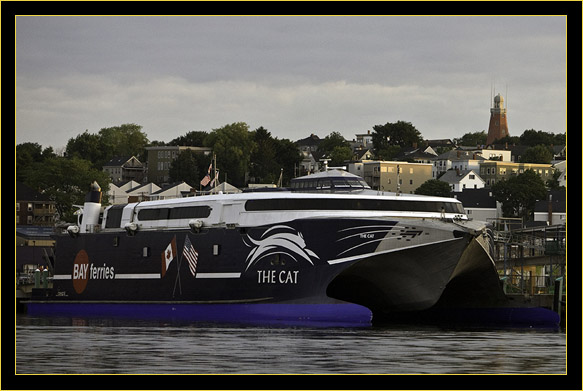
|
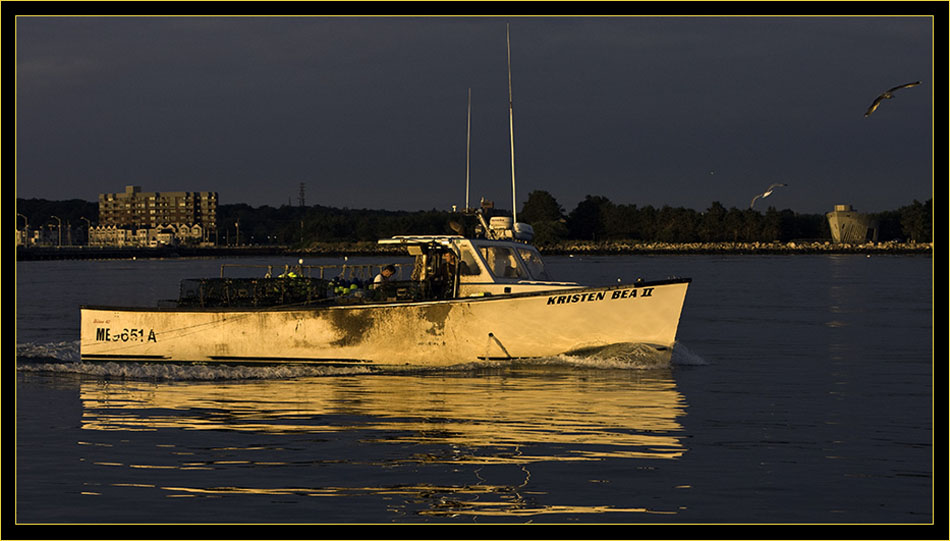
|
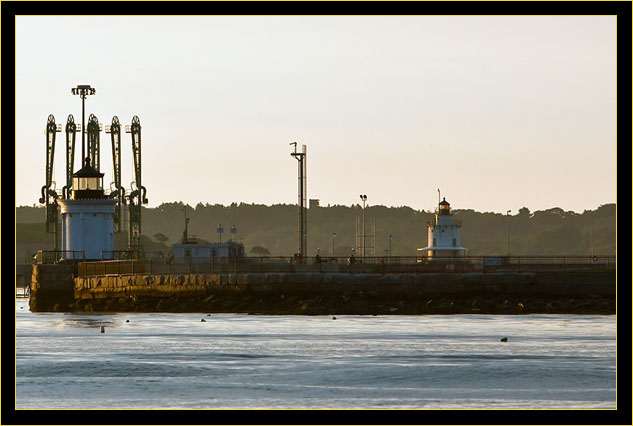
|
Local Aids to Navigation - Portland Breakwater & Spring Point Ledge Lights.The lighthouse in the left foreground, locally known as ‘Bug Light’ is officially named the Portland Breakwater Light. Local residents see this often enough in our day to day lives but many in the area don’t know much about the interesting history of this installation.In late 1831 Portland Harbor was ravaged by a fierce storm that caused significant damage to the surrounding area. Afterwards a breakwater was planned for the southern portion of the harbor’s entrance, part of which included a lighthouse construction. The work commenced within five years and the breakwater extended out around eighteen-hundred of a planned twenty-five hundred feet when the project was halted due to lack of funds, without a lighthouse… It wasn’t until 1854 when more funding was appropriated allowing construction of a lighthouse, a modest octagonal tower constructed of wood with a sixth-order Fresnel lens (pronounced Frey-nell - the design was invented by French physicist Augustin-Jean Fresnel). The breakwater wasn’t constructed to the planned elevation and as no Keeper’s house was built these were challenging times. There are accounts of the Keeper crawling on hands and knees to the structure in inclement weather while waves washed over the breakwater. The Greek influenced lighthouse we view today was constructed in the 1870’s and is a cast-iron cylinder surrounded by six fluted columns. There’s also far more to the story then I’ll post here – additional construction, decommissioning/re-commissioning of the light, WWII era landfill of the area for construction of Liberty Ships, changes to the breakwater and much more to get to the point of the installation as viewed today. It’s well worth closer investigation and a visit if one wishes to take the time. |
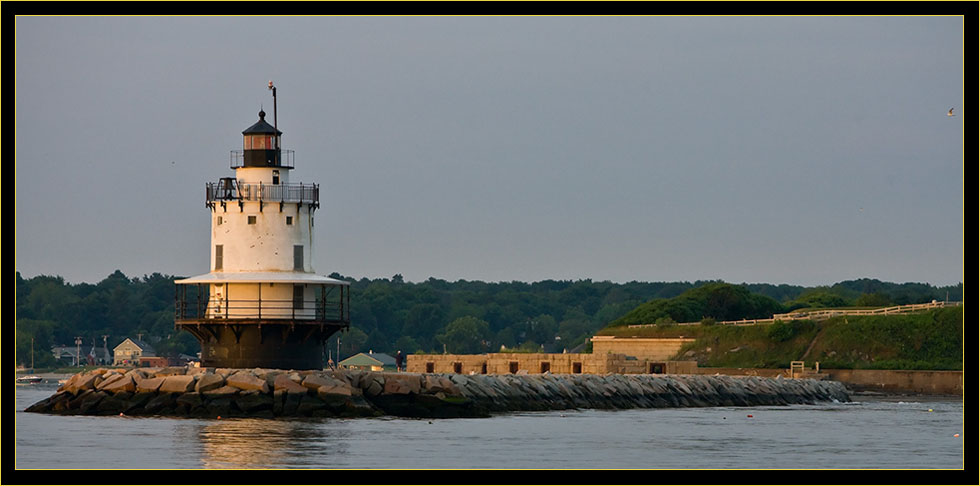
|
|
Looking at the previous images it can be noted that the sky conditions weren’t exactly conducive to allowing more than ample light into these scenes. Breaks in the clouds did allow some better conditions but these photographs were taken in low light. I adjusted my ISO rating to 640 to increase the shutter speed and took many of the early morning images in Program mode, which I generally do not employ. This isn’t exactly like automatic point and shoot mode on fixed lens cameras but it isn’t far from it. You still have control over exposure compensation – adjusting the amount of light striking the sensor, which is of paramount importance to good captures when using a right adjusted histogram method as I do. The histogram on a digital camera is a wonderful thing and if you learn how to view and use it the end result will prove most helpful. As we entered more or less open water Derek indicated we were heading towards Outer Green Island and the tern colony to see what we may find. Derek, ever watchful along with the spotters aboard, kept up a running commentary of the birds and other animals in view as we traveled along. None of these subjects were particularly close and the photographic opportunities for detailed shots were limited. Later upon review of the image files I was appalled to see how much noise was introduced into the images from this period. Some of this may be due to underexposure and then attempting to brighten the subject at the computer, but one is rarely successful on days as overcast as we had at this point. You’ll always get some shots but they may not be what you’d hoped. This was true for me on much of this day. I had no complaints however; it was a wonderful day to be on Odyssey and I was truly enjoying myself as we cranked along on a calm sea and beautiful morning. |
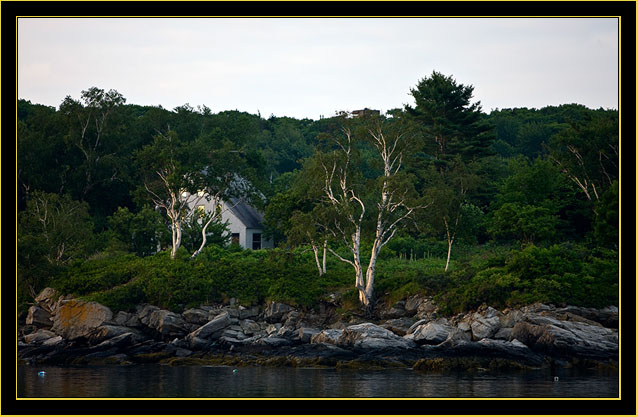
|
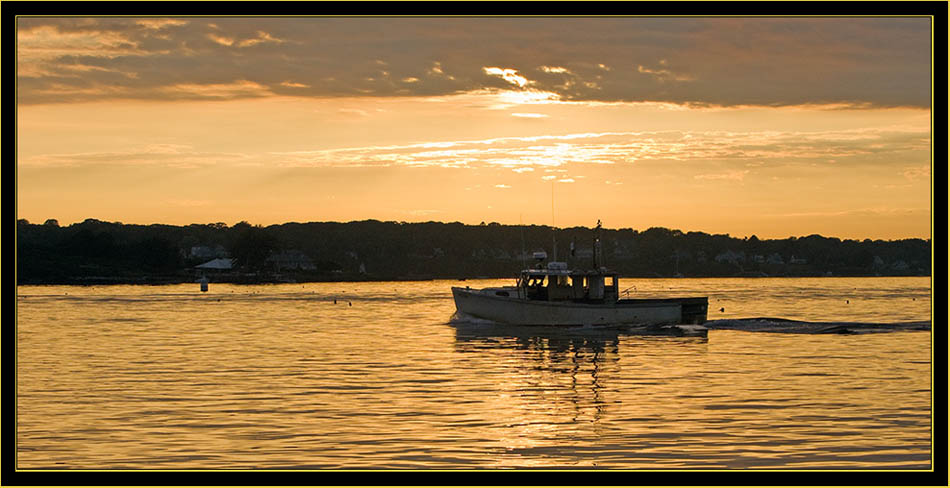
|
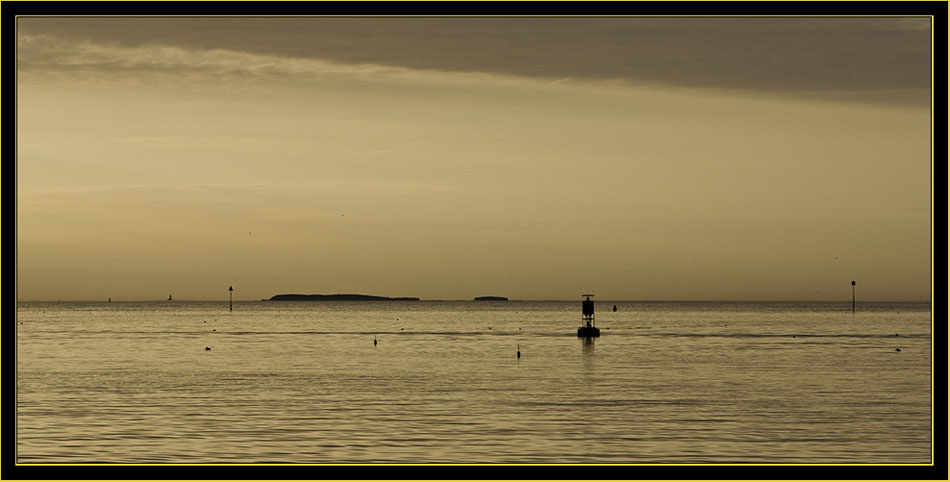
|
Around Outer Green Island
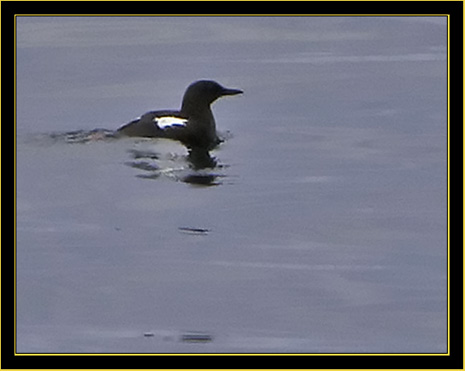
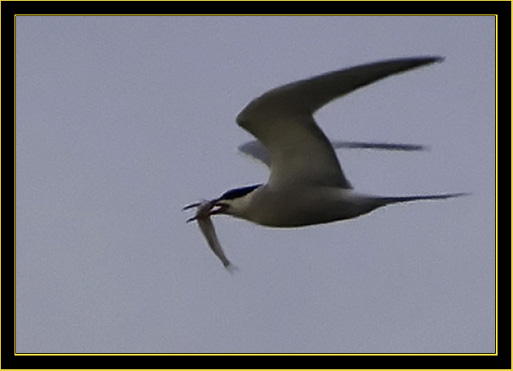
|
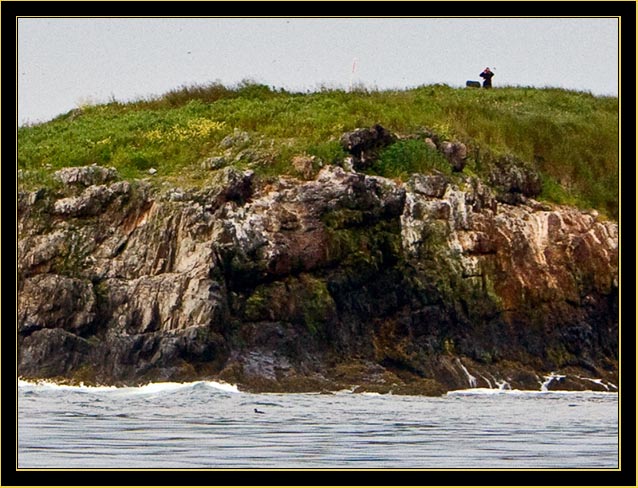
|
Our Captain indicated Outer Green Island is approximately 1.5 miles out of the harbor in Casco Bay. The island consists of just less than 5.5 acres; the length can be walked in a matter of minutes and it is owned/managed
by the Maine Department of Inland Fisheries
and Wildlife. In the early 1900’s it was a successful tern nesting site that was devastated over time by aggressive gulls destroying the young terns and people who killed the birds for feathers to create
fashionable hats for the ladies of the time.
Biologist from various groups recognizing the island’s location would prevent incursions from land-based predators, developed a program to restore the once prevalent native tern population. The Gulf of Maine Seabird Working Group, a coalition working to protect seabirds to historic working sites approved a plan of action for the restoration effort in 2001. I’m certain Derek can expand upon the treatment implemented to bring the terns back to the island & he has visited the site on occasion. Although the recent efforts are deemed successful and are closely monitored by a dedicated group of biologists who give up much in the way of creature comfort in this endeavor, there is still far to go to restore the nesting site to its former glory. An excellent article from The Boston Globe dated August 2004 pursuant to this effort can be found at: Biologists Turn Maine Island into a Tern Haven. As we passed the island not much can be seen other than some blinds that break the horizon and lots of birds flying and going about the active routine of their daily lives. There were quite a few species of birds in the water around the island but we didn’t tarry long in this location. One of the crew viewing the island asked if what he was seeing in the distance was a person – and indeed he was correct. A biologist on Outer Green Island was watching us as we cruised along heading further out. |
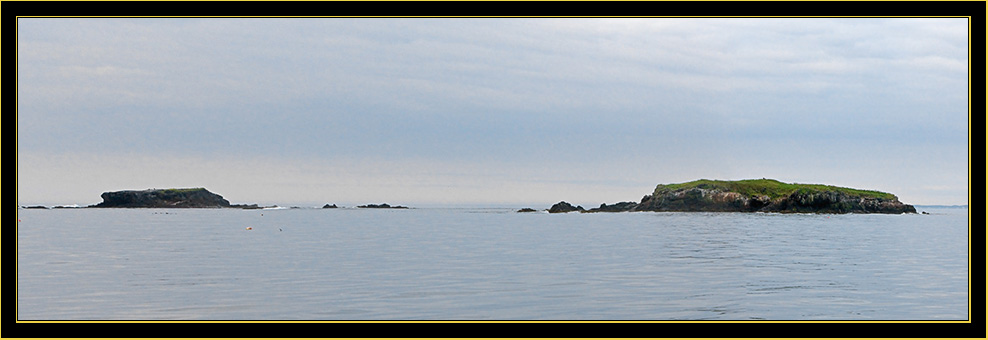
|
Common Tern views below: left, 1/1600 at f/8, ISO 640; right, 1/3200 at f/4.5, ISO 640. This pair was photographed at 280mm later in the morning in more advantageous light, accounting for the much faster shutter speeds.
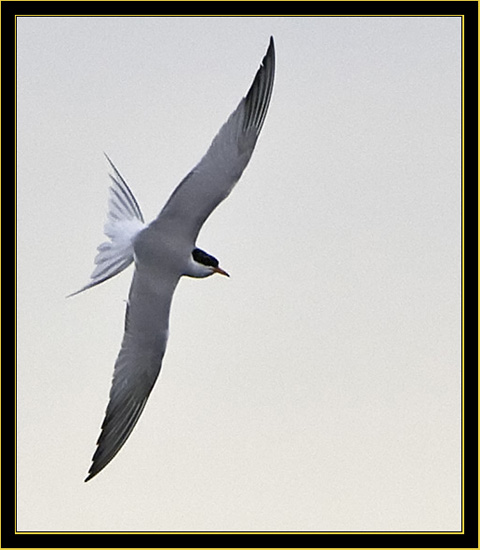
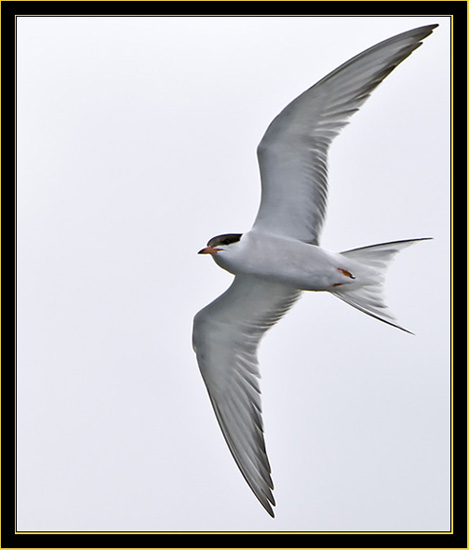
|
|
It wasn’t long after passing Outer Green Island before Dan got set up and started throwing chum over the stern rail. He had a large bag of popcorn, several gallons of oil and a mess of bait. With his raingear and gloves on he went right at it as I sat near the stern waiting to see what of interest may fly by to investigate the greasy trail. A pair of Double-crested Cormorants flying low on the water; 1/1000 second at f/6.3, ISO 640 at 200mm. Derek also pointed out a pair of Great Blue Herons
far out at sea that we thought was a bit unusual.
|
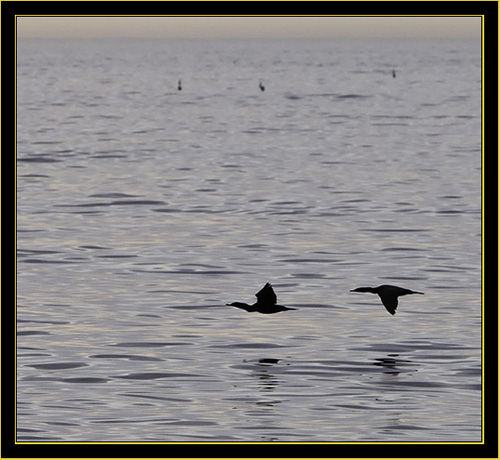
|
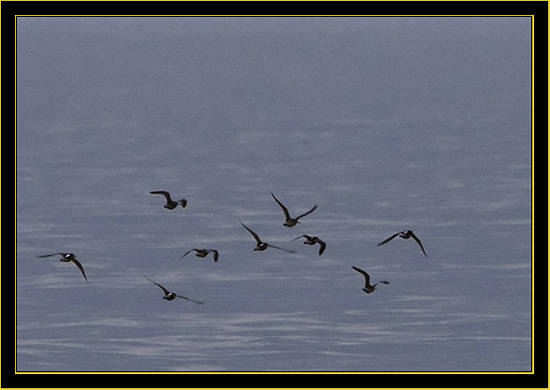
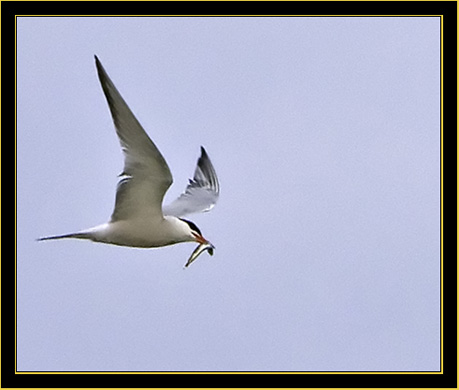
|
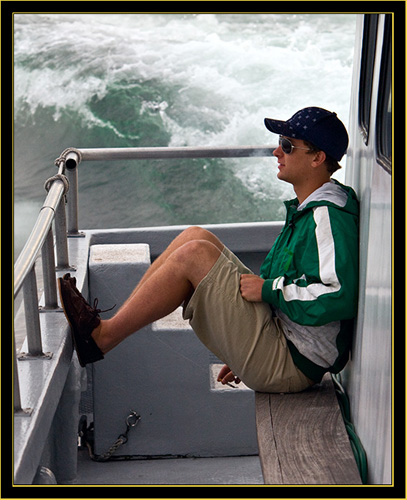
|
On the way out we’d passed many of the typical birds we expected to see – Common Eiders, Cormorants, Black Guillemots, Laughing Gulls
& Herring Gulls, various shorebirds and others. I didn’t try to keep a list but
I’m certain Derek did as he always records what is viewed in between the other tasks he was addressing. Then there were the Harbor Seals frolicking about and small groups of Porpoise occasionally. I took some shots of interest here
and there but nothing was close at this point so mostly, like all of us not working aboard, we kicked back, viewed the sights, looked for birds or whatever and enjoyed the morning.
It wasn’t quite 0630 hours yet...
Crewman taking a break near the stern. |
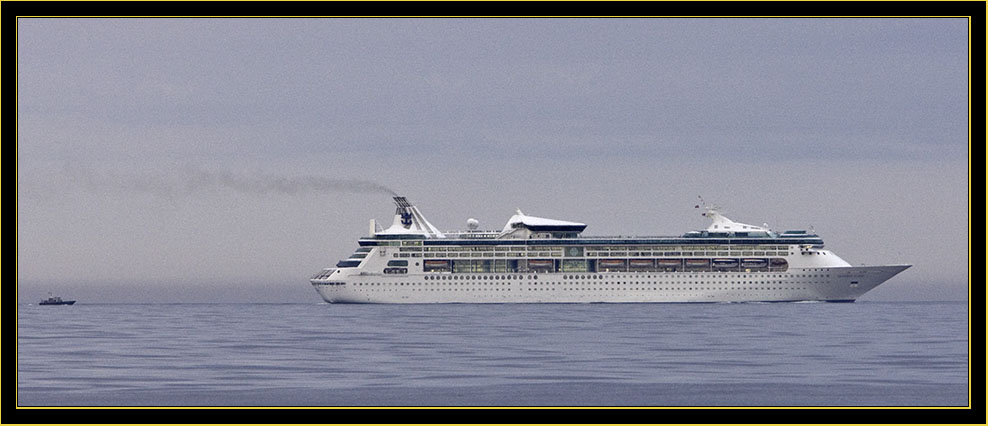
|
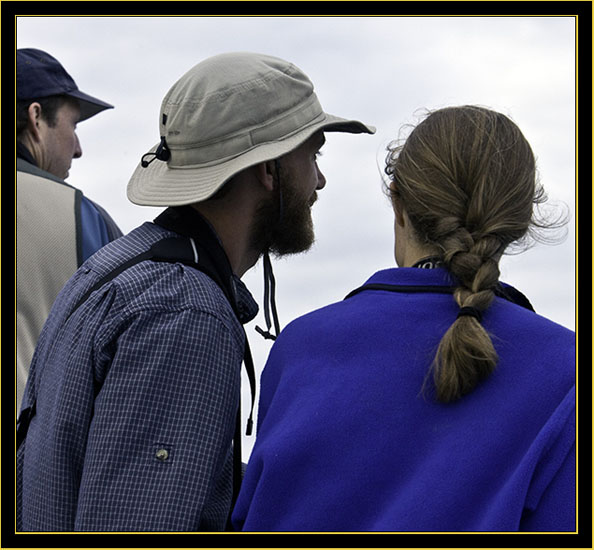
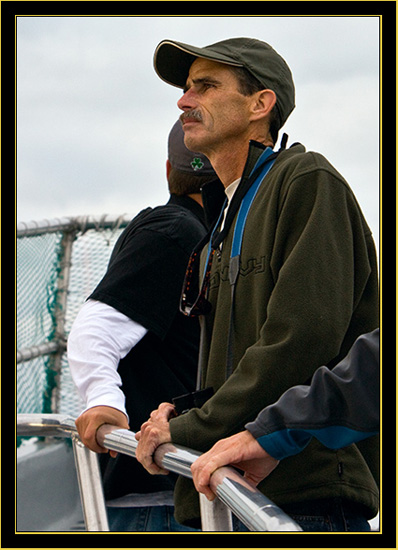
|
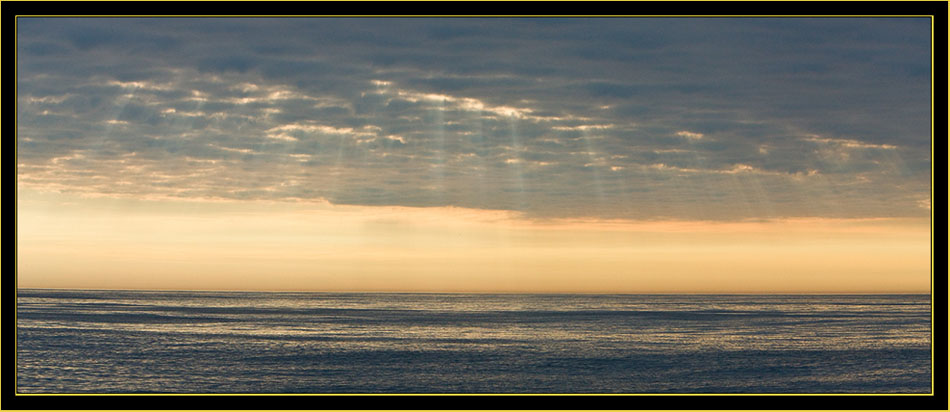
|
|
A few Minke whales had been spotted but they didn’t appear to stay above the water for long. I would have obtained a few photographs of some of these had the opportunity allowed but this wasn’t the case. Minke Whales are the second smallest of the baleen whales and from what I’ve read, one of the most abundant of the baleen species. At maturity they obtain a length of around twenty-two to thirty feet (depending on what source one may reference) and are viewed often in Maine waters from my experience. I may have to hook up with Odyssey at some time to attempt getting some images of these whales. A Great Black-backed Gull meandering over a calm sea. 1/1600 second at f/10, 280mm, 640 ISO. 'Sibley's' notes these as the largest of the gulls.
|
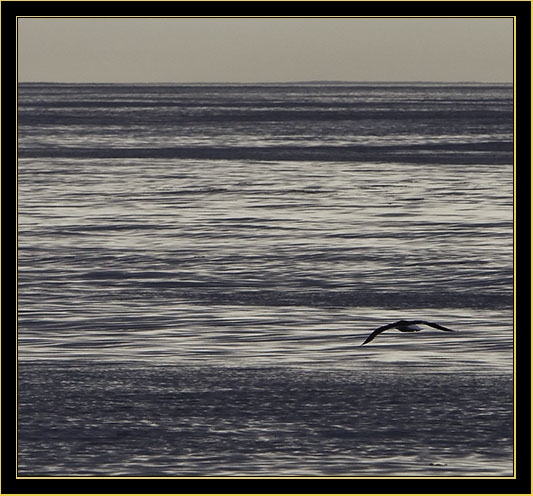
|
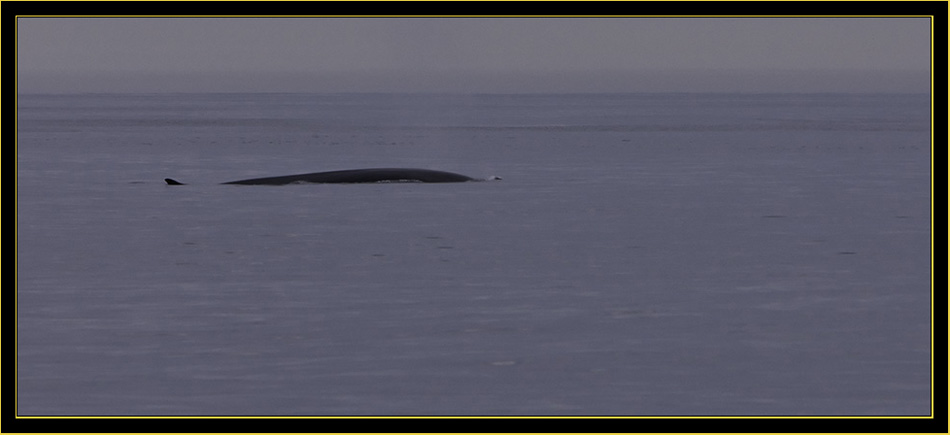
|
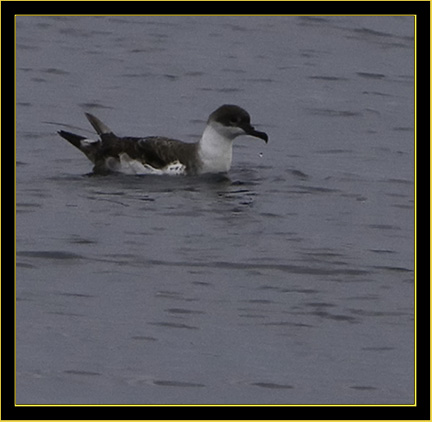
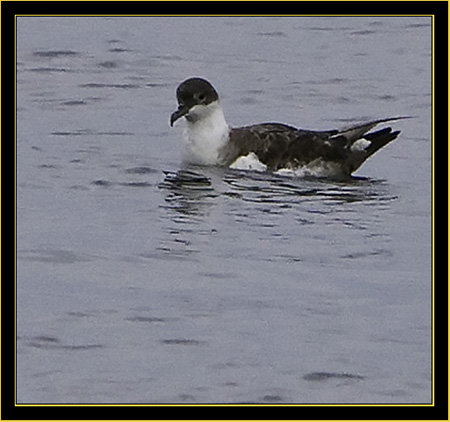
|
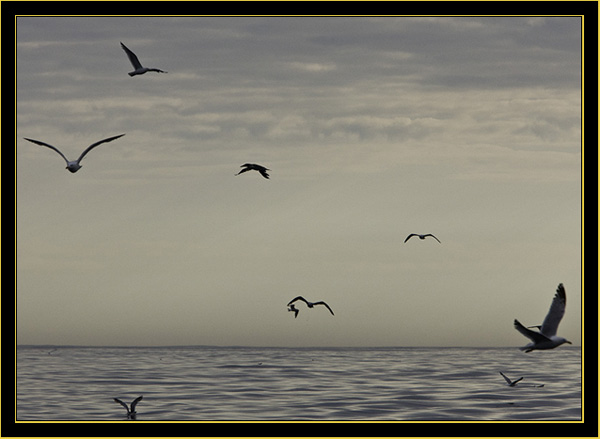
|
Meanwhile at the stern, Dan continued to chum, sometimes alone, at others times with another party assisting. I stayed near him to keep an eye on what may be developing in Odyssey's wake but
this trip was realizing much less activity than we hoped. We had Herring Gulls in smaller groups following Odyssey with an occasional Great Black-backed but other than gulls none of the other pelagics were present we’d hoped to see.
I figured this dearth of birding opportunities wouldn’t make Derek any too pleased with his concern over customer satisfaction... We discussed this occasionally when he was taking a break from his intercom duties. I indicted that birding was much like a fishing expedition – you just never know what one may find. I’ve stated before and will do so again, you may go out on any particular day and be disappointed with what you find, however, if you don’t get out at all it’s a certainty you won’t see anything. I had no regrets about the morning and was enjoying myself as the time fly by. The apparent deficiency of sightings wasn’t due to any lack of effort. The spotters and crew along with all the participants were glued to their binoculars searching and Captain Dan clearly was up for anything in the timeframe the charter allotted our group. We had a wonderful group of people onboard Odyssey. |
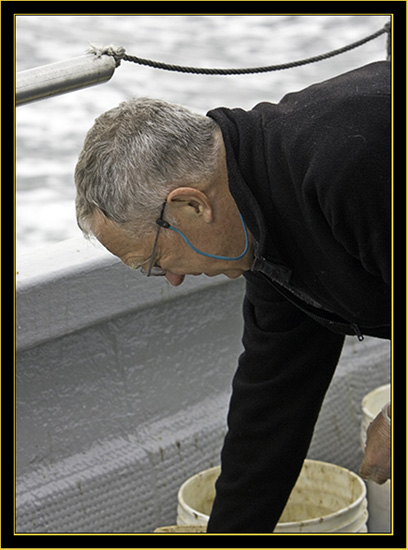
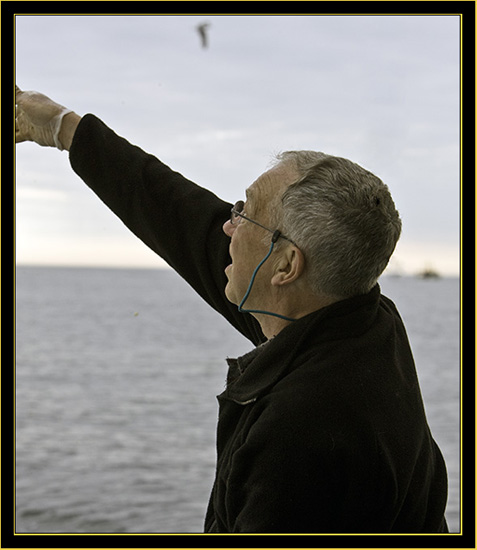
|
|
Below - Dan had been chumming constantly all this time. When he asked what time it was he commented that he had to be more careful with pacing the goods going overboard as it appeared he was going to run out before he’d have preferred. With this news I figured that this was about as good as it was going to get so decided to line up some shots on the birds we had following. Although we didn’t have the traffic we’d hoped there were still a decent group of gulls about and time to find some new species that may be in the area. I believe we were a bit spoiled after last year's tremendous turn out of birds. |
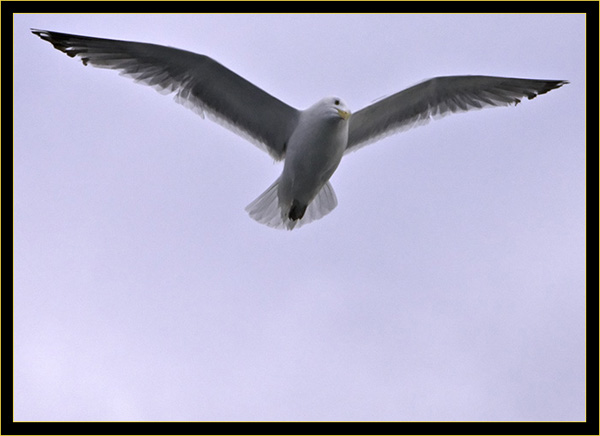
|
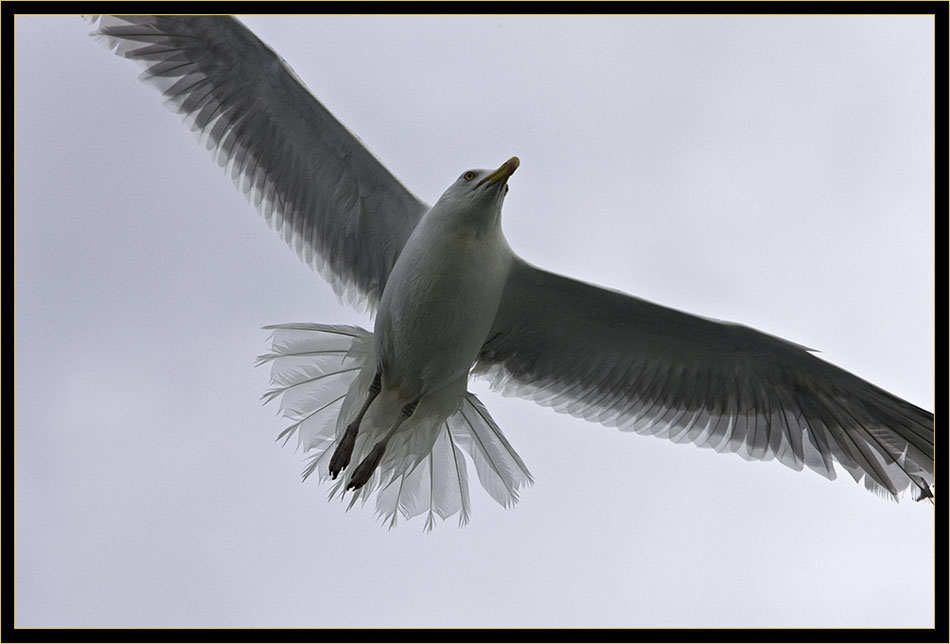
|

|
Kiro's Gull Sampler...
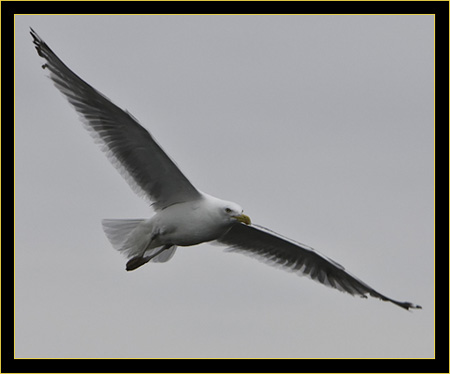
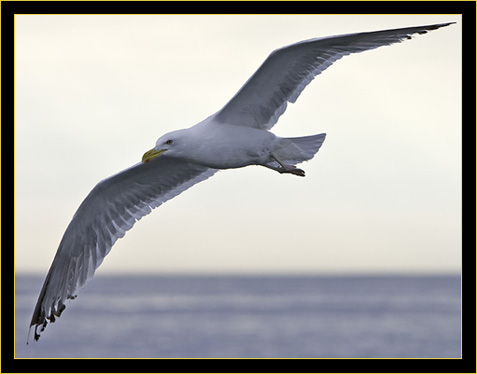
|
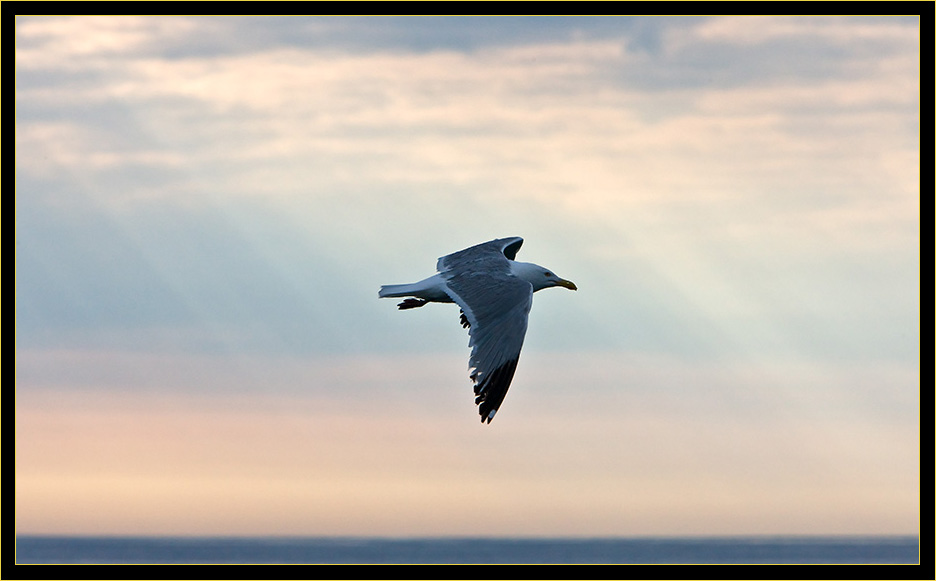
|
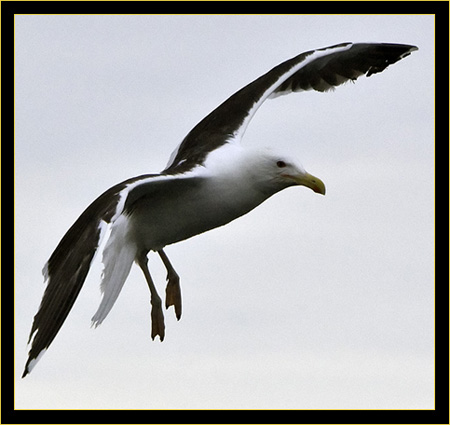
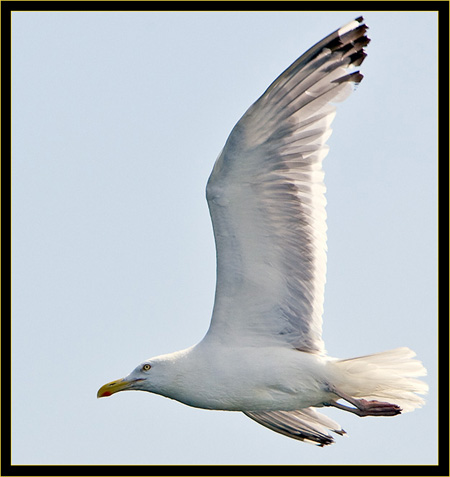
|
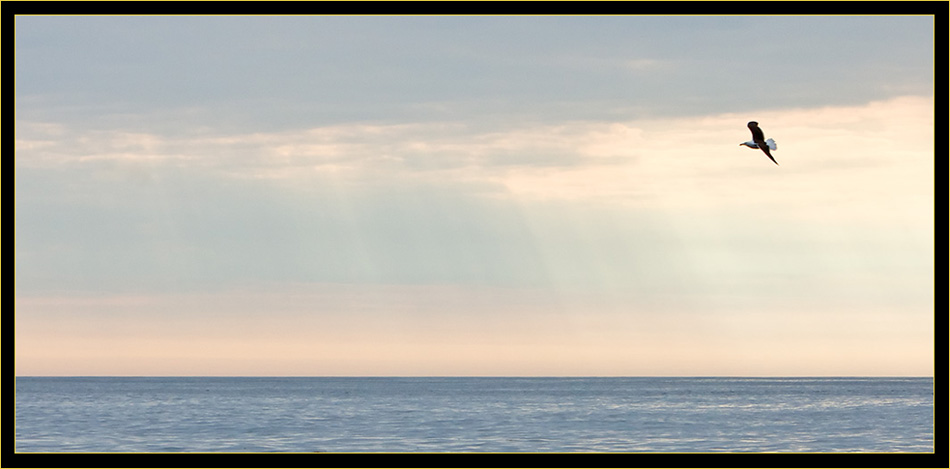
|
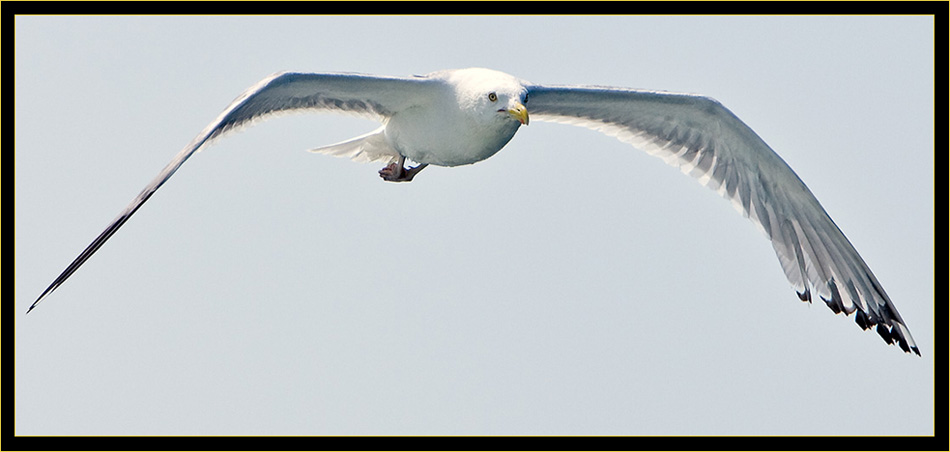
|
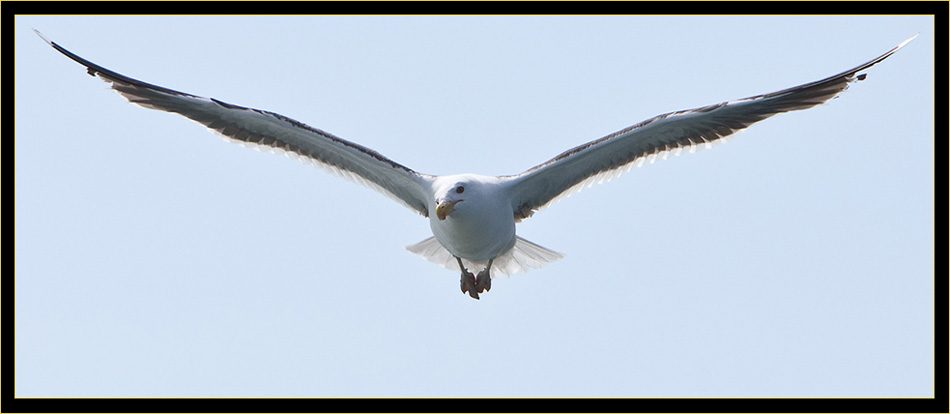
|
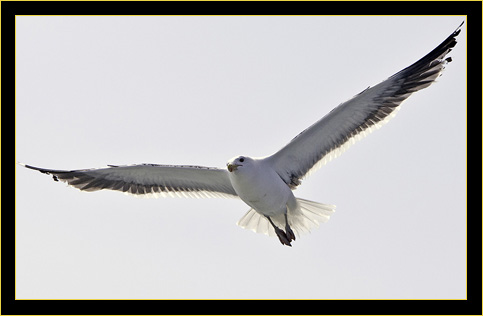

|
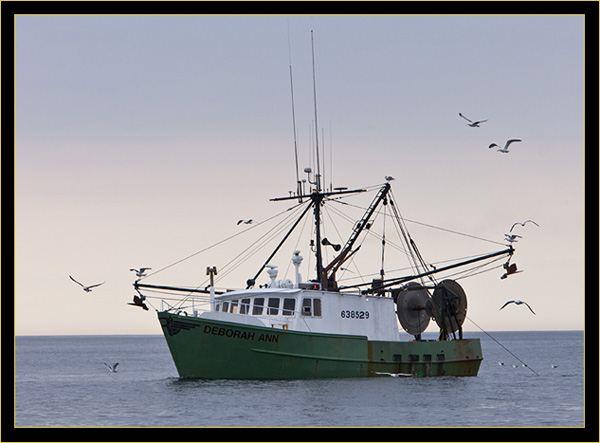
|
The trawler Deborah Ann was in the area working. This vessel looked like they had as many birds around as we had following Odyssey… |
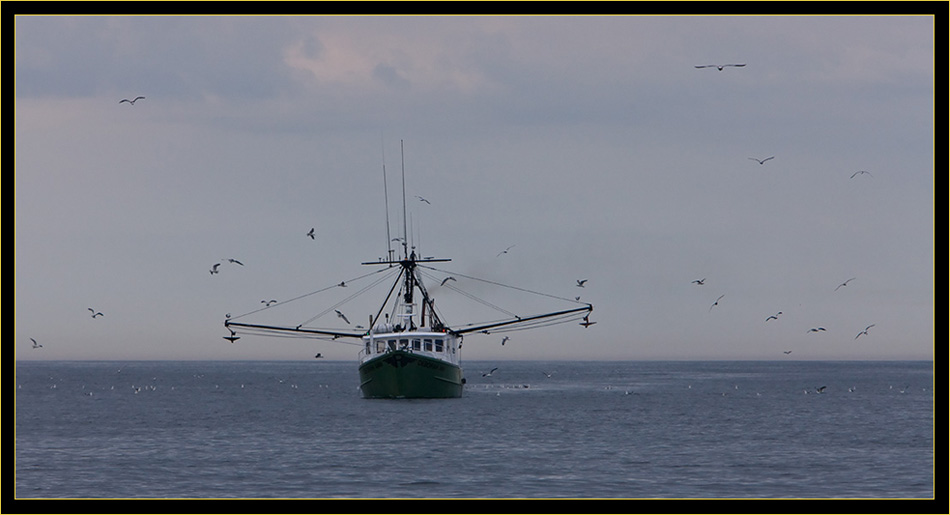
|
|
We did see quite a few birds during the morning overall. Derek kept the commentary of sightings going fairly constantly and I tried to listen wherever I happened to be at the time to learn if I needed to relocate for a potential shot. Several Sooty Shearwaters flew by and I got a few shots on them at distance, none with good backgrounds or any that came out particularly well upon review. Another that flew by on more than one occasion was the Wilson’s Storm-Petrel, a difficult bird to capture with the camera as they are quite small and quick. Several Northern Gannets were spotted at various times and I always tried to get the lens on these birds when I was able. Again none of these came in close and none of the other species appeared particularly interested in the chumming operation other than a quick flyby to see what the commotion was all about. I considered trying another lens or camera combination but ended up not changing. I’d been experimenting between the Mark III’s one-shot and the AI Servo Autofocus modes to determine what worked best for this type of image capture. The one constant for the day that proved a disappointment was the amount of noise introduced in the files at 640 ISO. Reflecting on this it was clearly the day as I’ve shot with this camera with the same settings often and was aware of how the files generally appear. One has several options in a case like this. One would be to reduce the ISO to a more moderate speed like 400, but this would only slow the shutter speed. You can also shoot the lens wide open or perhaps closed up one or two stops. This is what I elected to do and kept the aperture at f/8 for most of the wing shots. It was a good day for low-light seascapes and similar shots as one enjoyed the trip, but not so auspicious for birds on the wing in the dull gray background of the sky. I could have used more direct light, which I did have on occasion and quicker shutter speeds to aid the evaluation. Many imagers aren’t interested in photographing birds on the wing in times of cloudy weather or gray sky conditions and this is the reason. No matter what though, it’s always enjoyable and good practice. Like in fishing, you don't always catch the big one... |
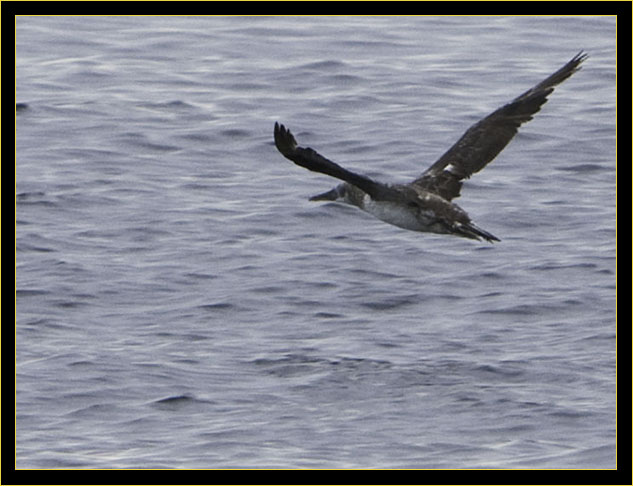
|
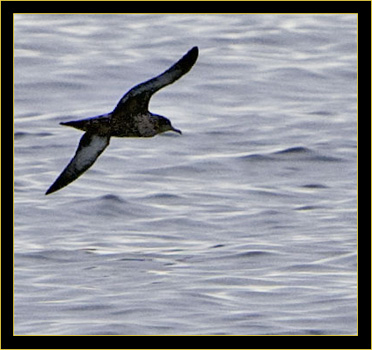
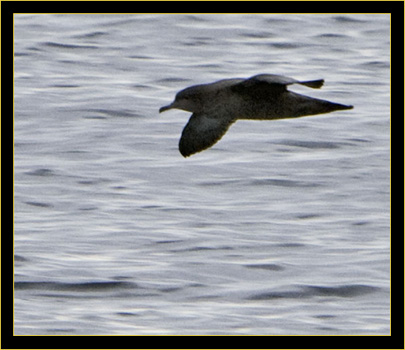
|
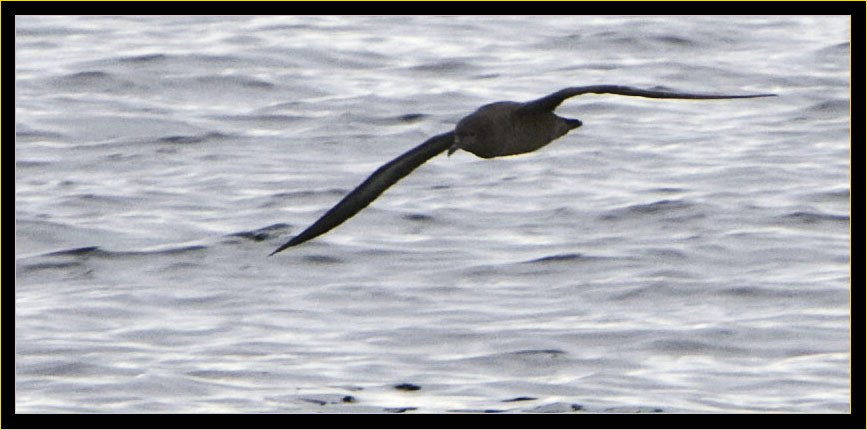
|
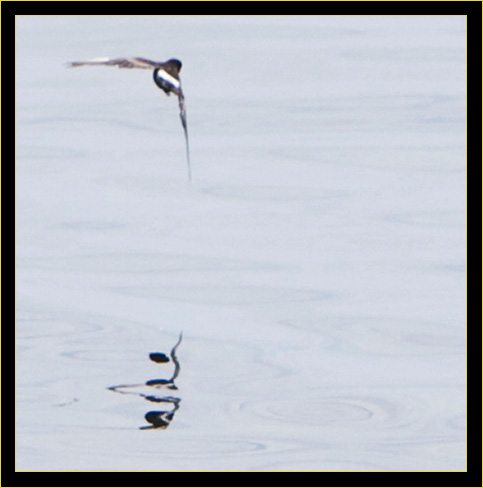
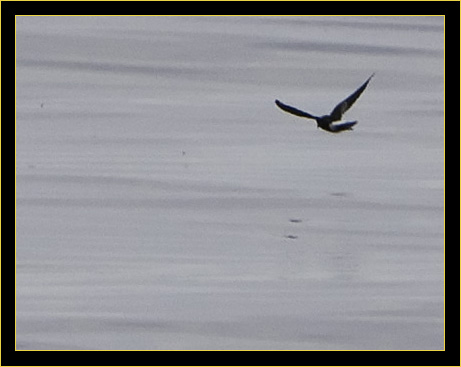
|
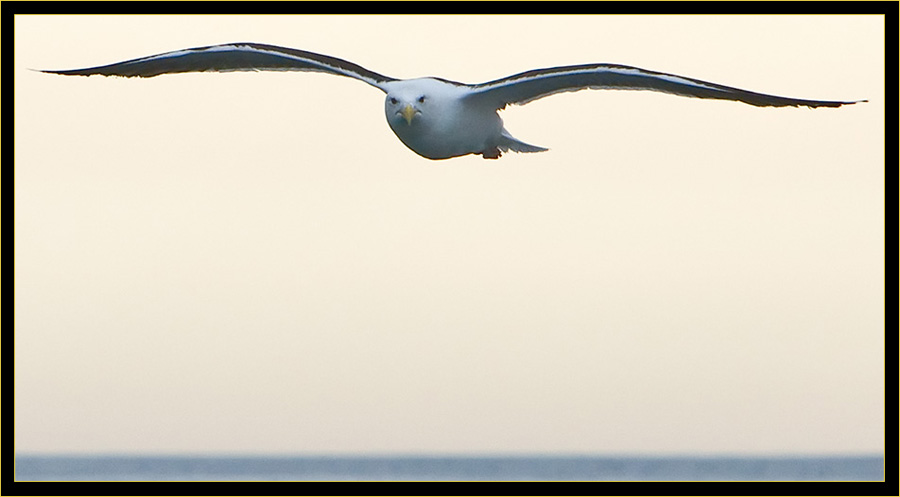
|
Finbacks - Close Encounter
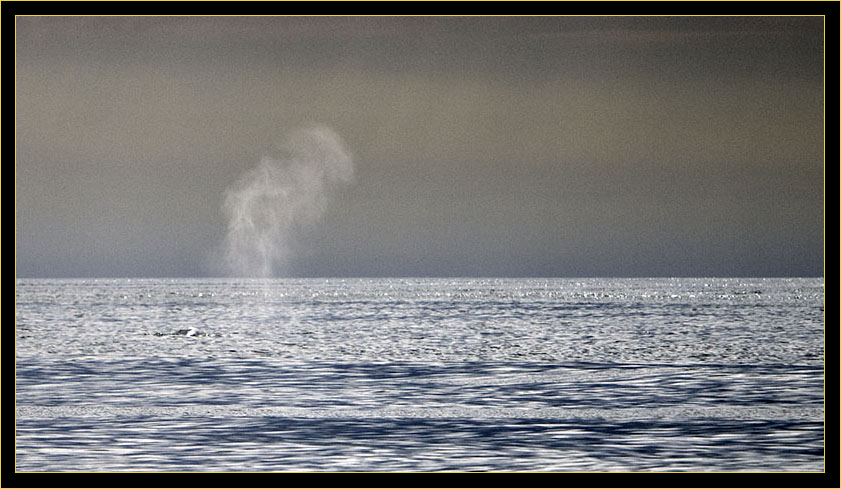
|
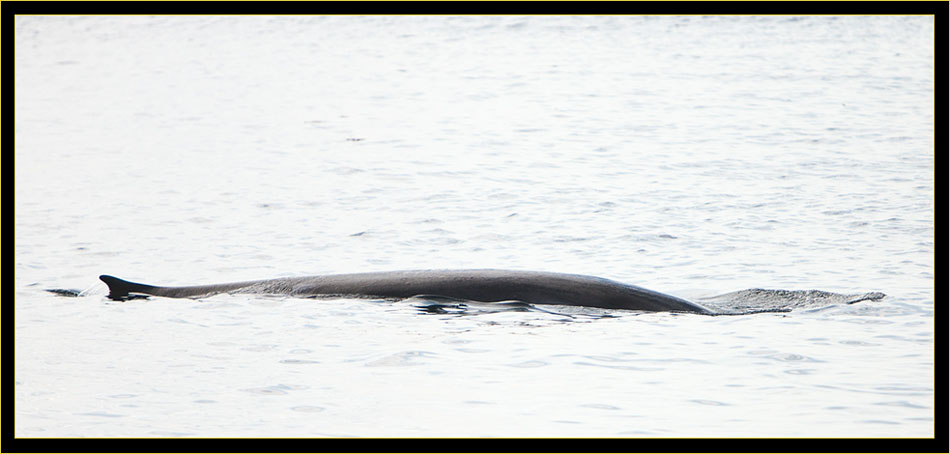
|
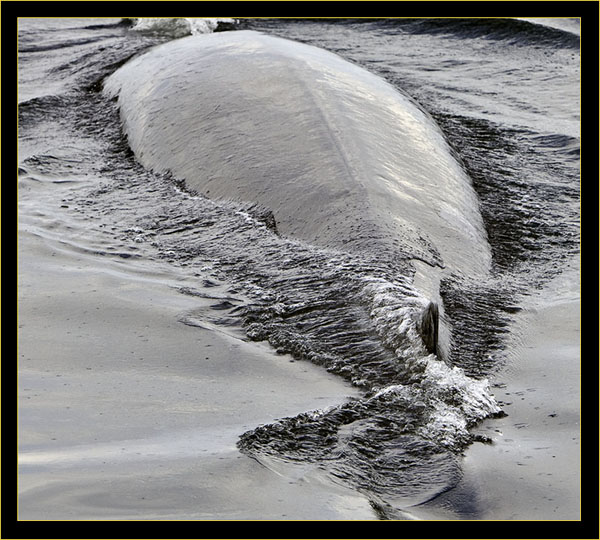
|
Finback Whales (Balaenoptera physalus), also called the Fin Whale or Razorback, is a marine mammal belonging to the suborder of baleen whales. They grow to a length of 70 to 80 feet or more depending on what source you’re referencing.
They are second in size only to the majestic Blue Whale (these can reach one hundred feet in length) making the Finback the next largest living creature on our planet. Finbacks are also noted as the world’s fastest whale and can
obtain speeds of up to 35 miles per hour. They have eight to nine hundred baleen plates which they employ in feeding on fish and krill eating two to three tons of fish daily.
It has been said that whales are the heart of the sea – I can see why and am in absolute agreement... Finback Whale - 1/640 second exposure at f/6.3, ISO 640, 140mm focal length |
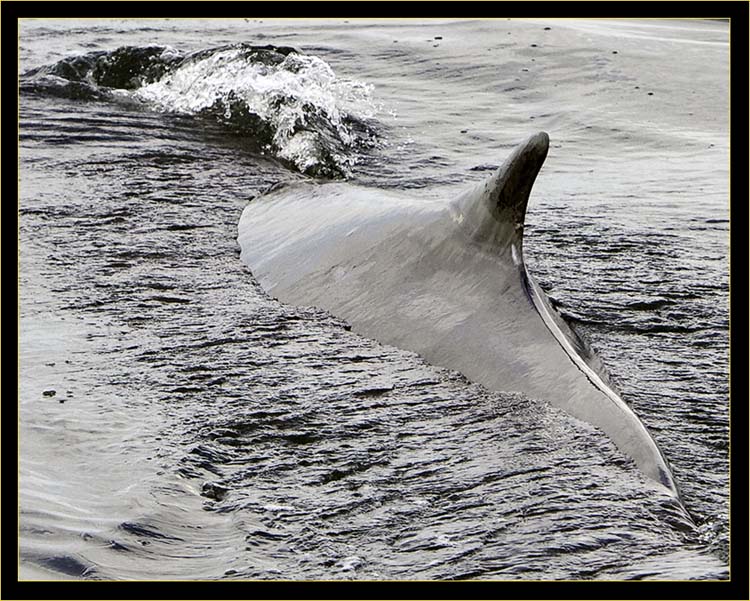
|
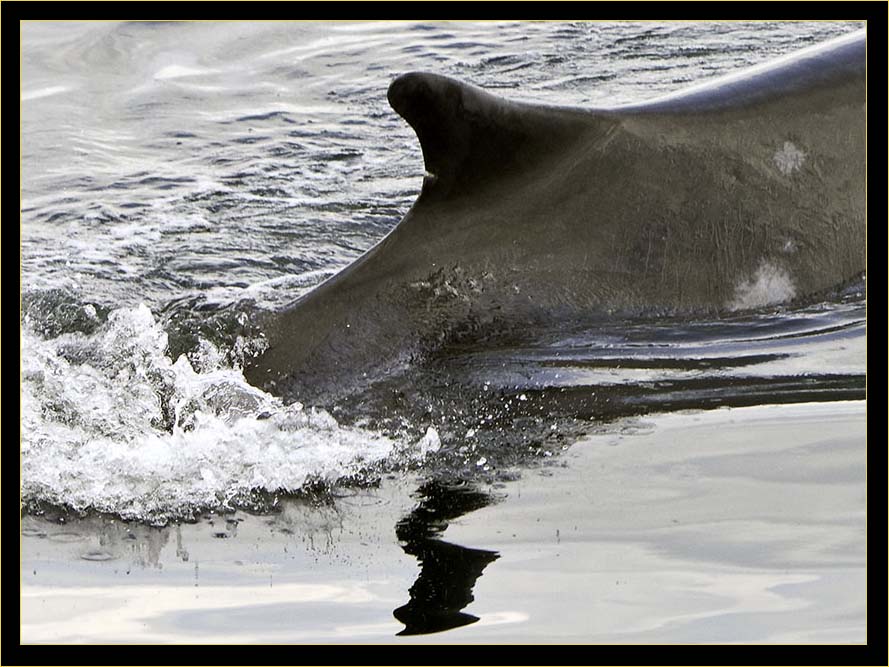
|
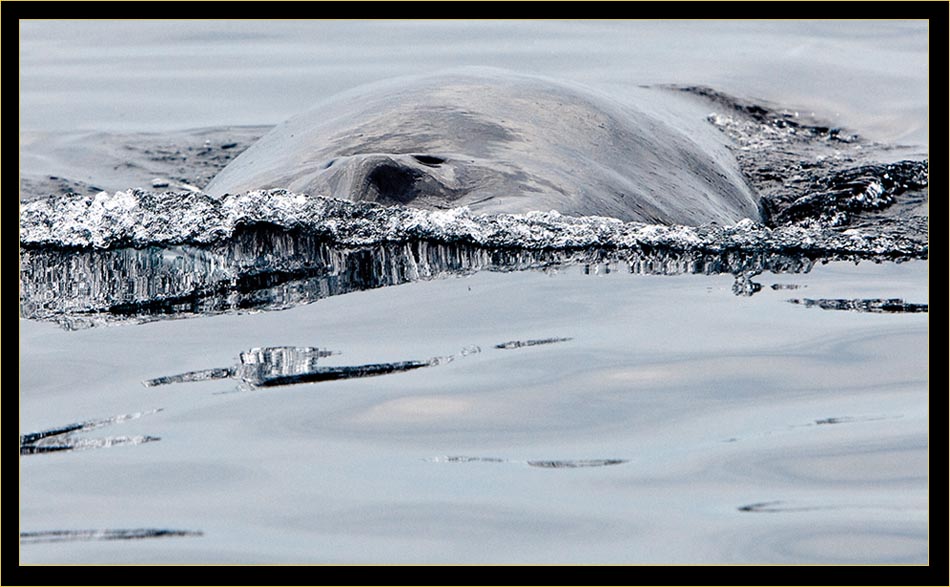
|
|
At right is the man himself, Derek Lovitch, viewing our whale encounter. I’ve informed him in our home we never refer to him as Derek – he’s always ‘The Master’ when Linda and I speak about him. I actually believe he thinks I was kidding… I’m certain there’s a great deal of planning that goes into one of these trips and I recognize he had concerns about who would attend as well as what we may find. All I can say is thanks Derek for making this morning possible, anyone who missed out did so at their loss. I’ve had the privilege of having Derek serve as my personal guide from time to time on photographic outings. These trips are always terrific, educational and successful. I’ve added many birds to my Bird Photography Index in Derek’s company and plan to continue. I cannot assert enough in the positive about Derek’s enthusiasm, field expertise, conscientious attitude and energy level. There is one downside I’ve found however. Derek’s idea of a fun outing, especially if you both have open schedules that day may include a hike from Yarmouth to Wells or similiar to look for a rarity. I’d advise asking what he has in mind before you head out… Everyone should investigate attending the Saturday morning bird walks originating out of their Wild Bird Center of Yarmouth location. These are free, a wonderful learning experience and professionally administrated. If you’re interested in birding and sights in nature in general you’ll find Derek a font of information and a good deal of fun to take the field with. Derek also writes regularly to his interesting and informative blog posted to the Mainetoday website. This is always worthy of note and I recommend you check it out at Derek's Birding Blog. The Master on watch…
1/2000 second at f/4, ISO 640, 98mm focal length. Notice the sky was clearing around 0830.
|
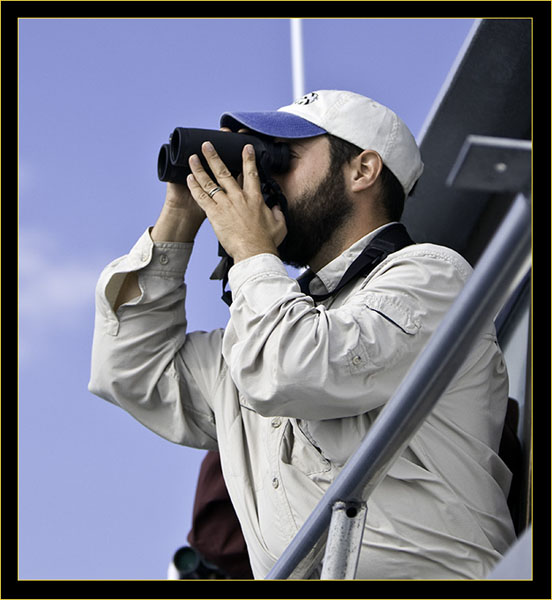
|
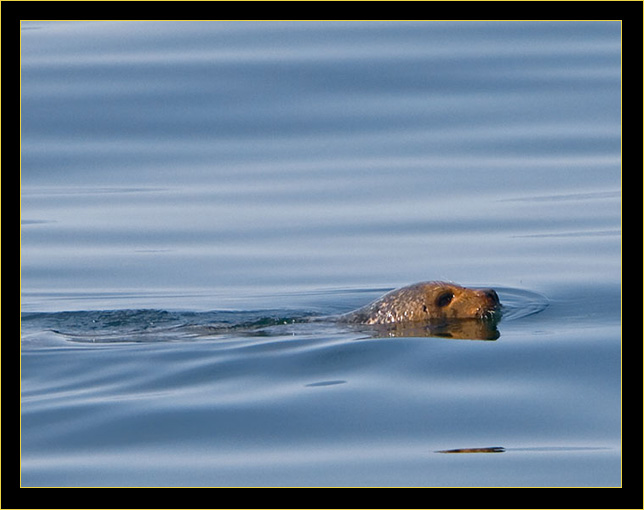
|
After the finbacks went off to new adventures the captain turned Odyssey away to see what else we may find. As we cruised along I viewed this Harbor Seal swimming along parallel to our course. I figured the seal was close enough to warrant
a few exposures so I extended the zoom to maximum reach and took the image viewed at left.
We cruised around for nearly an hour as Derek pointed out anything that entered our field of view. This was a quiet period and everyone was enjoying the sun starting to break the cloud cover and warm the scene. Dan had about ceased the chumming process having run out of material, so collectively we kept watch and relaxed. Even the gulls that had been in the chum stream were fairly subdued. With few targets of opportunity available photographically I moved around the vessel and ended up on the upper observation deck where now and then I took some shots of our shipmates for the morning. I offer apologies in advance to anyone aboard not indicated in the images to follow. I had no intention of photographing people and what few images I obtained in this regard were arbitrary in nature. Harbor Seal – 1/640 second at f/8, ISO 500 |
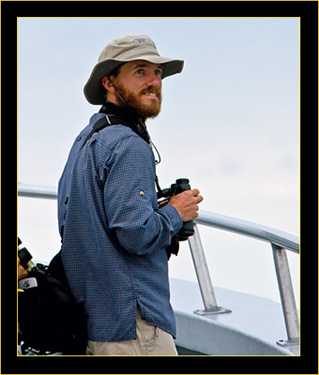
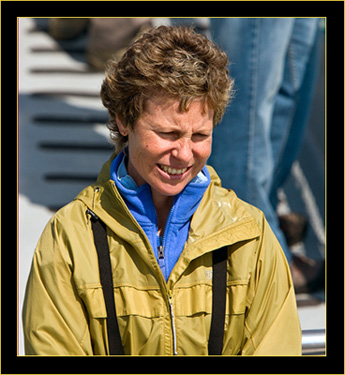
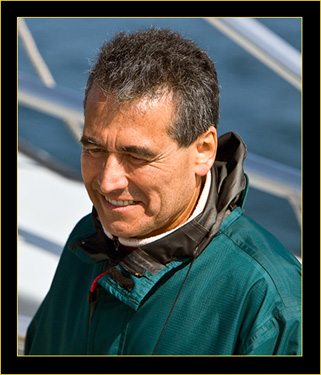
|
|
Jeannette Lovitch keeping watch from the upper observation deck... Between the crew, ‘official’ spotters, Derek, Jeanette and the balance of the passengers it’s unlikely much got by without being spotted. It was a fine day to be on the water and quite enjoyable. Bill is standing behind her back to and Derek can be seen in the wheelhouse at left. |
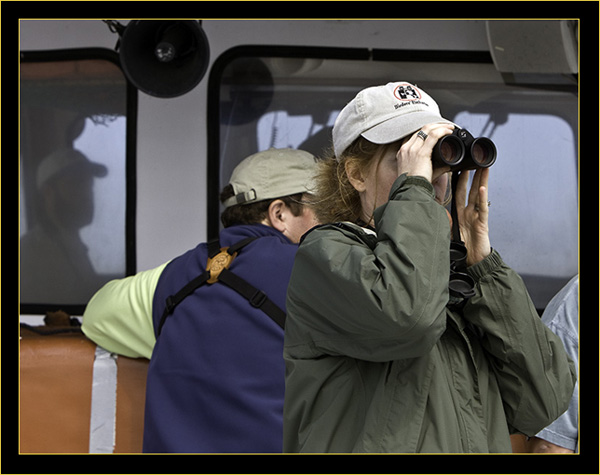
|
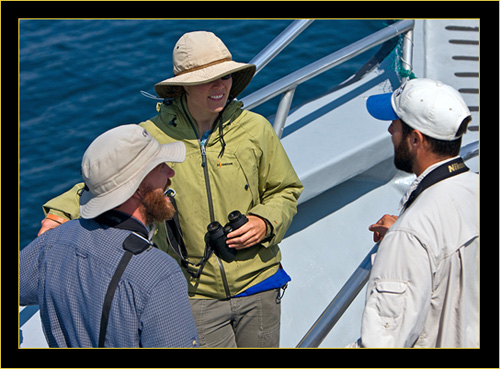
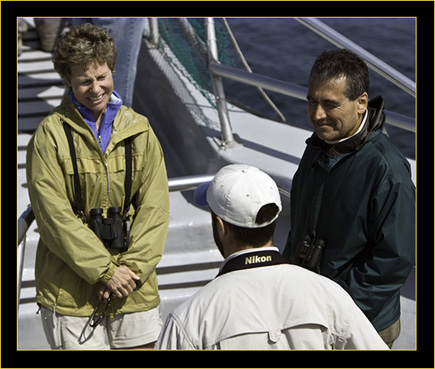
|
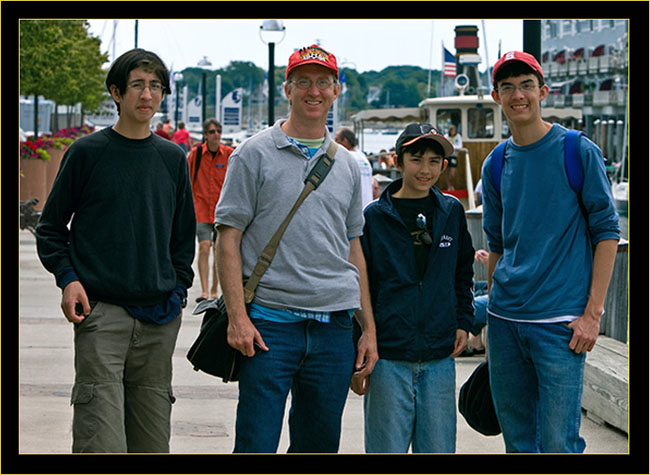
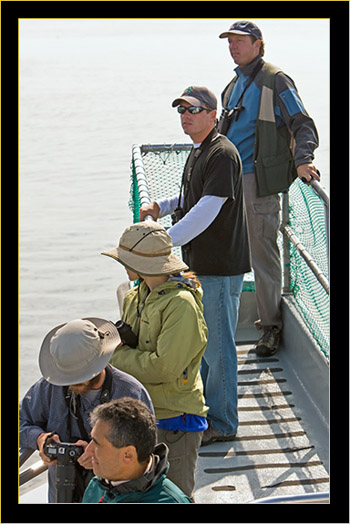
|
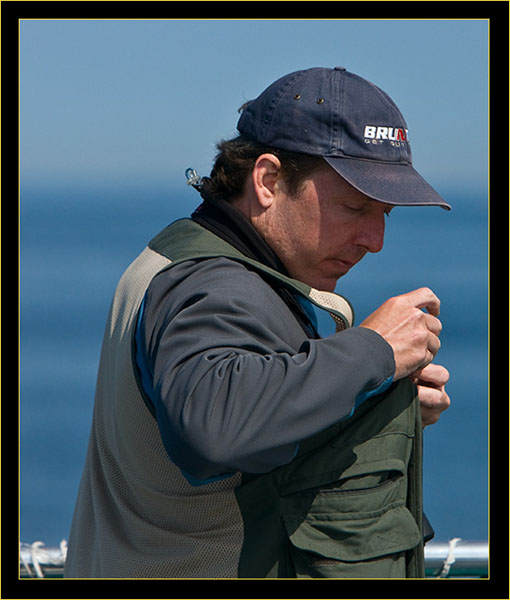
|
At left – Ed Hess making an adjustment on his vest. He served as the forward spotter for this trip and spent nearly all the time at or near the pulpit conducting a careful watch on the sea and surrounding airspace.
I learned from previous expeditions that Ed is a terrific birder and all around good man. It was great to see him on this trip.
As we watched the sea a message came over the loudspeaker of a distant fin sighting. As everyone tried to locate the spot Captain Dan maneuvered Odyssey to close the distance for a closer investigation… |
Basking Shark - Another Surprising Visitor
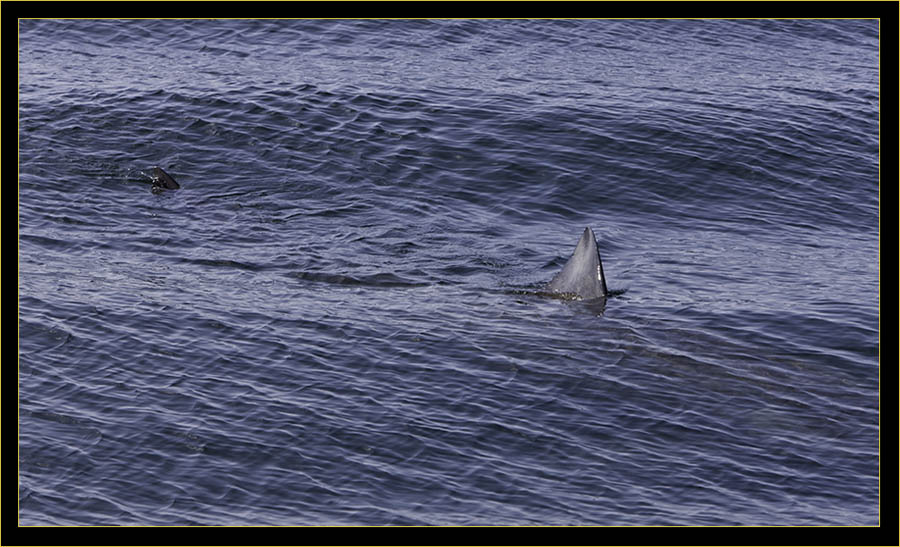
|
|
The Basking Shark (Cetorhinus maximus) is the second largest fish in our seas, the only larger being the Whale Shark, and is one of the most recognizable. Needless to say, this was an unexpected sighting and as Derek pointed out a few days later far more rare than we realized at the time. This shark and the finbacks alone were worth the ‘price of admission’ this day… This large creature can grow up to thirty or forty feet (again source dependent), is a filter-feeder with grayish brown to black coloration on the upper surface and off-white or darker on its belly. Its huge mouth is used to collect food that floats in the water. A sluggish swimmer with a gill structure that nearly encircles the circumference of the animal, this shark has a liver that can account for up to 25% of its body weight. The liver is high in squalene, a low-density hydrocarbon that helps give the shark near-neutral buoyancy. We viewed a Remora hanging around the shark that is visible in the image at right at the base of the dorsal fin. I was on the upper deck when we came alongside this shark and in a excellent position to shoot down into the water. |
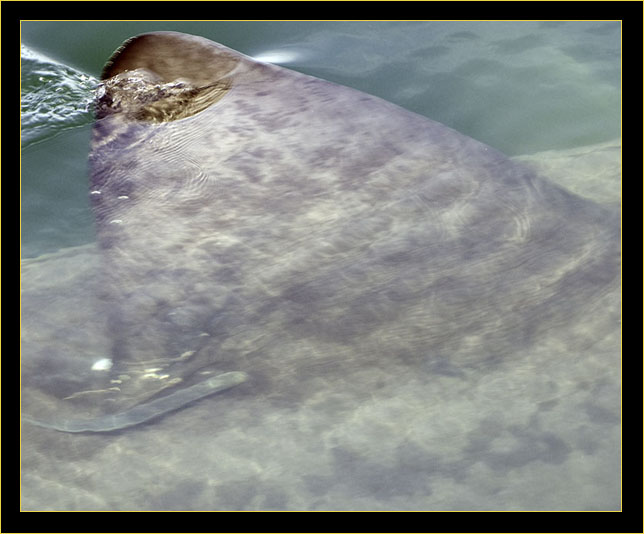
|
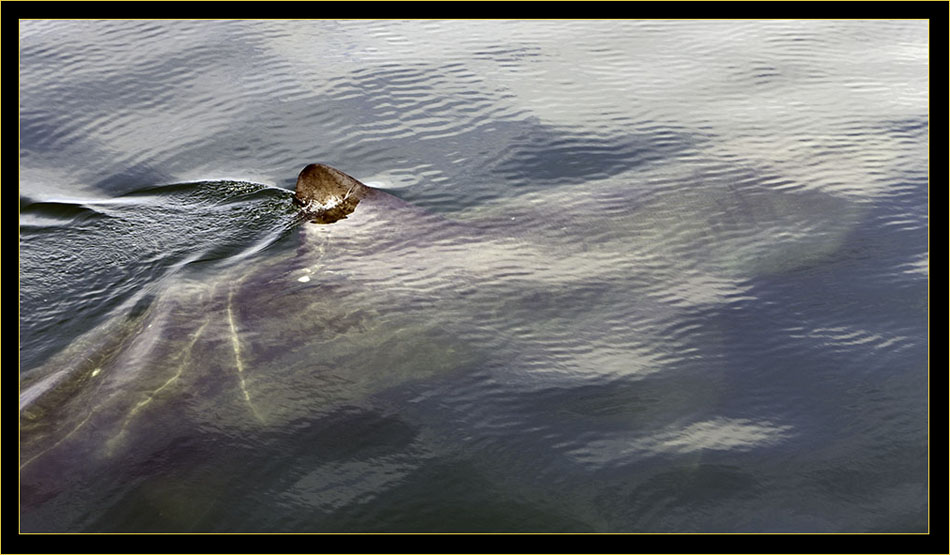
|
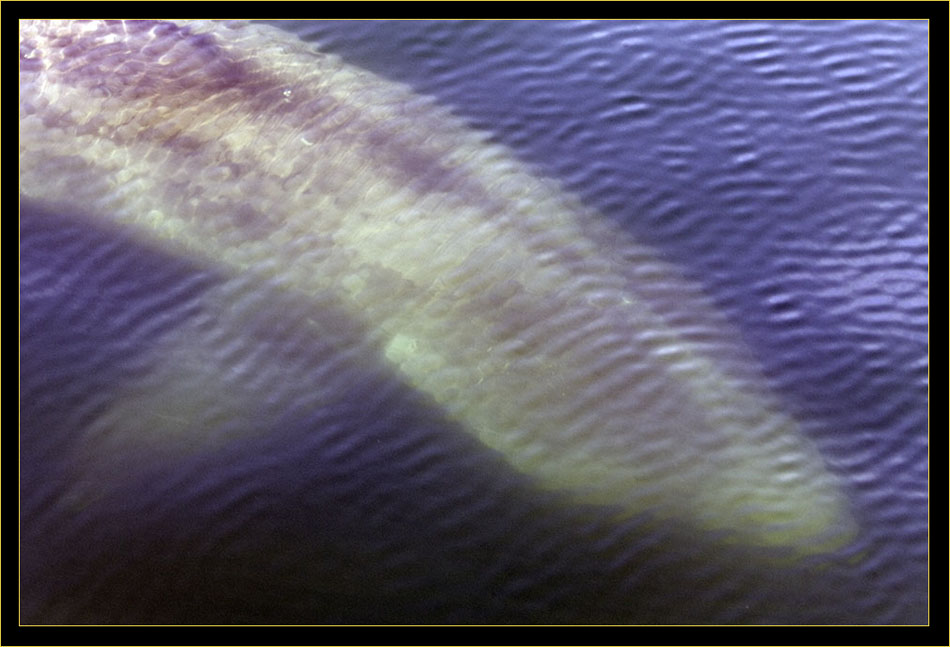
|
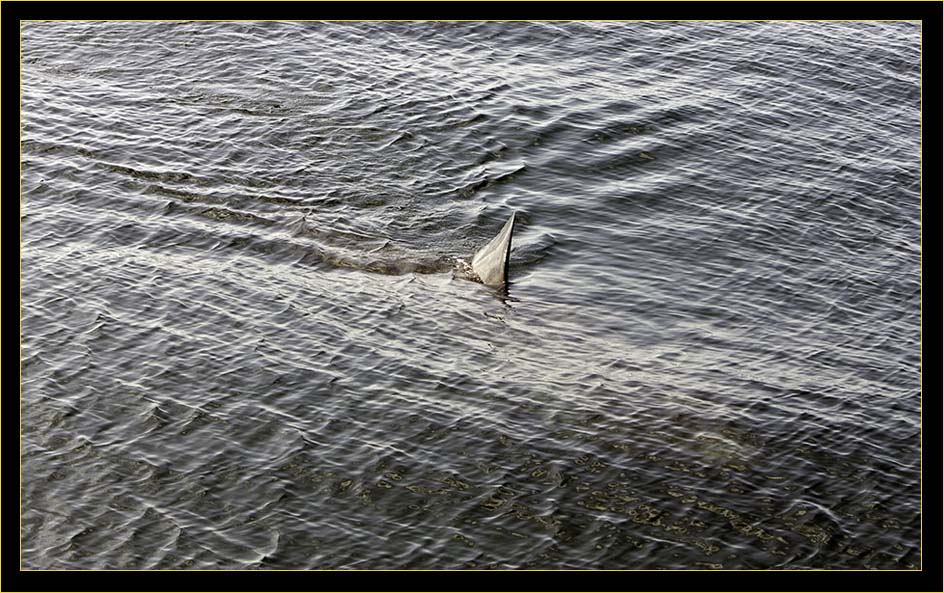
|
The Return Trip & Fire at Sea
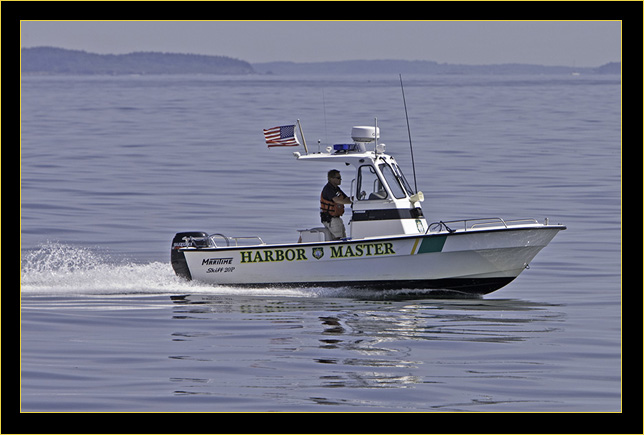
|
Local radio traffic informed our captain that a boat had experienced an electrical fire not far from the area we had recently departed. Once this was known it was a simple matter to determine where this event had occurred as the smoke
from this fire was extensive and visible at great distance. In the end result, although Odyssey would normally have assisted in any fashion possible, we continued to head in as rescue boats, including the Coast Guard, had been dispatched
and would arrive quicker to the scene than Odyssey.
The Harbor Master on route to the fire scene. 1/800 second at f/7.1, 270mm at ISO 500 |
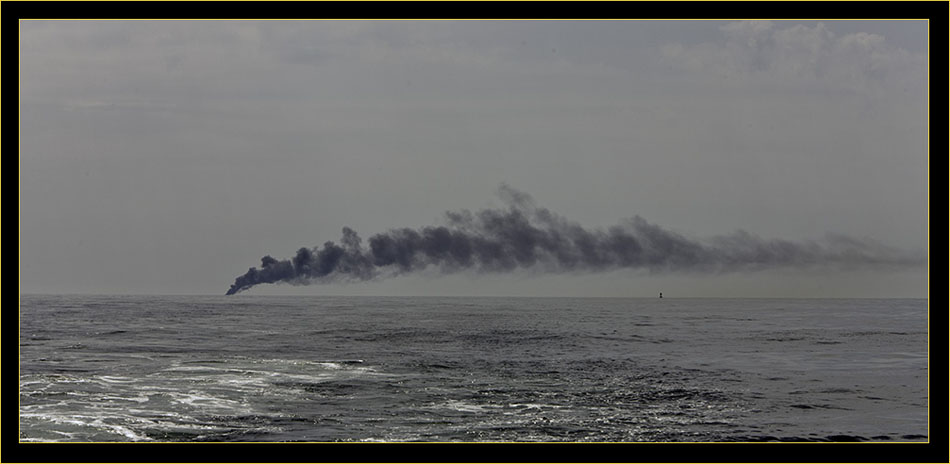
|
|
We learned little about the event at this time but the next day a short article appeared in the Portland Press Herald pursuant to the incident. This article described that the forty-five foot lobster boat Kimberly Marie suffered an explosion that blew the single occupant off the stern of the vessel. Once the fire commenced the lobsterman radioed the emergency & donned his survival suit which was fortunate, as shortly afterwards the vessel exploded blowing him into the water. He started swimming six-miles off Cape Elizabeth and was rescued shortly thereafter by a sport fishing boat in the area. The Kimberly Marie was listed as being out of Cundy’s Harbor and was deemed a total loss. The lobsterman suffered rib injuries and was transported to Maine Medical Center. A Coast Guard Cutter streaking out to sea passing Portland Head Light. 1/800 second at f/7.1, 260mm at ISO 500
|
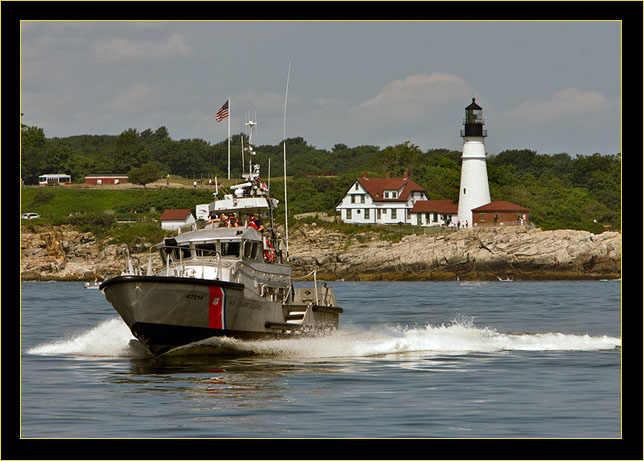
|
Final Views at Morning's End
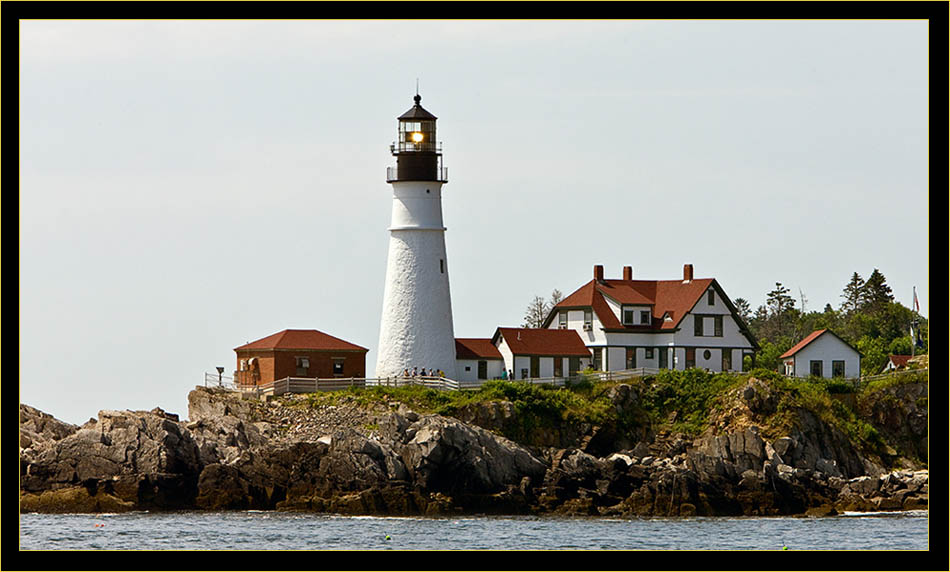
|
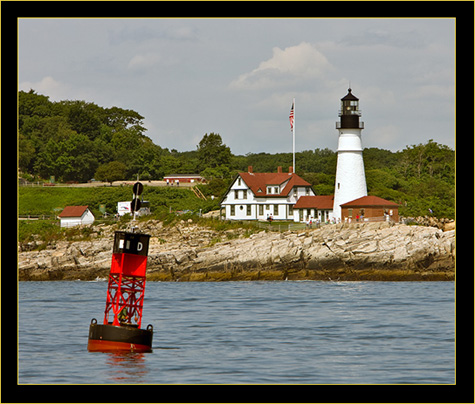
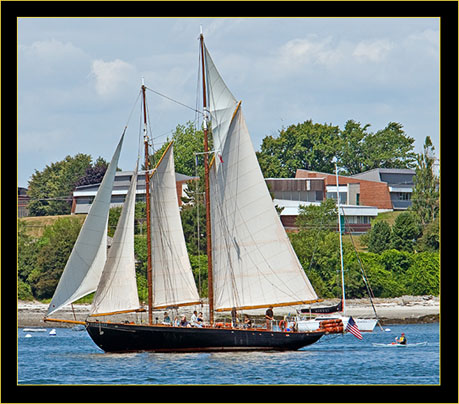
|
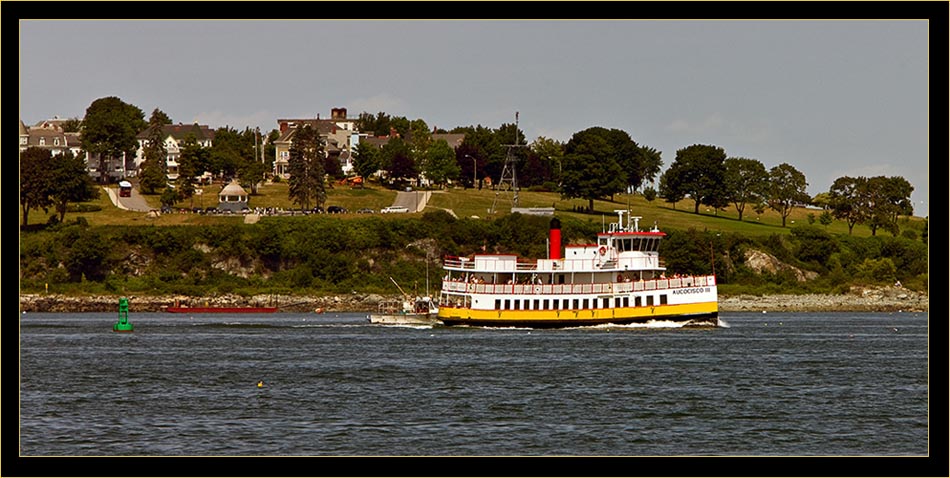
|
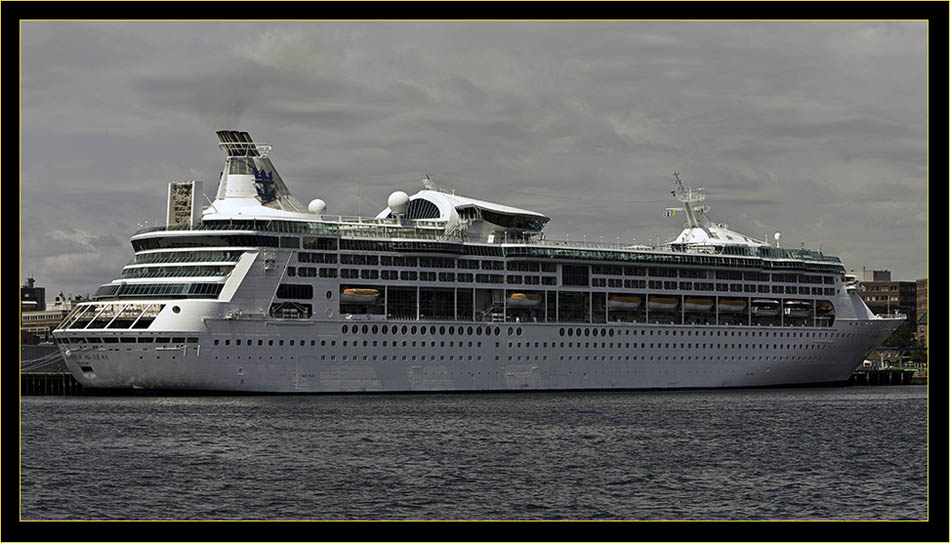
|
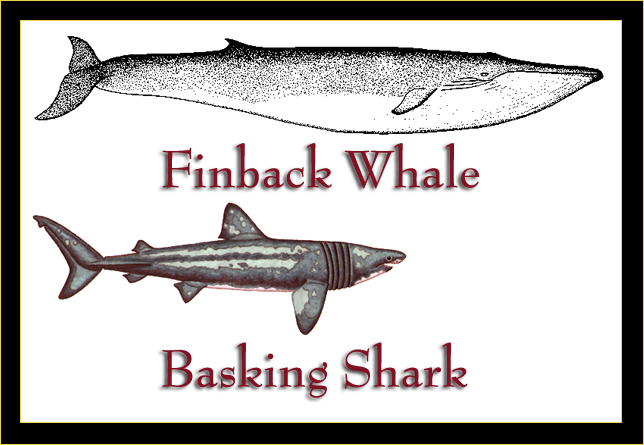
|
It had been an outstanding five-hour outing and one I was more than pleased to have participated in. Although the recent weather patterns didn’t appear to be conducive to finding pelagic birds
the trip was worthwhile in many aspects. Adding new whale shots to my photographic archive plus finding a Basking Shark was exceptional and went far in erasing any possible disappointment pursuant to bird activity…
In closing, I wish to thank Captain Dan Yates and the crew of Odyssey for an extraordinary time along with Derek & Jeannette Lovitch of course first and foremost and Paul & Anita Guris for making this adventure possible. I for one look forward to the next voyage so you folks please start planning… |
July 2008